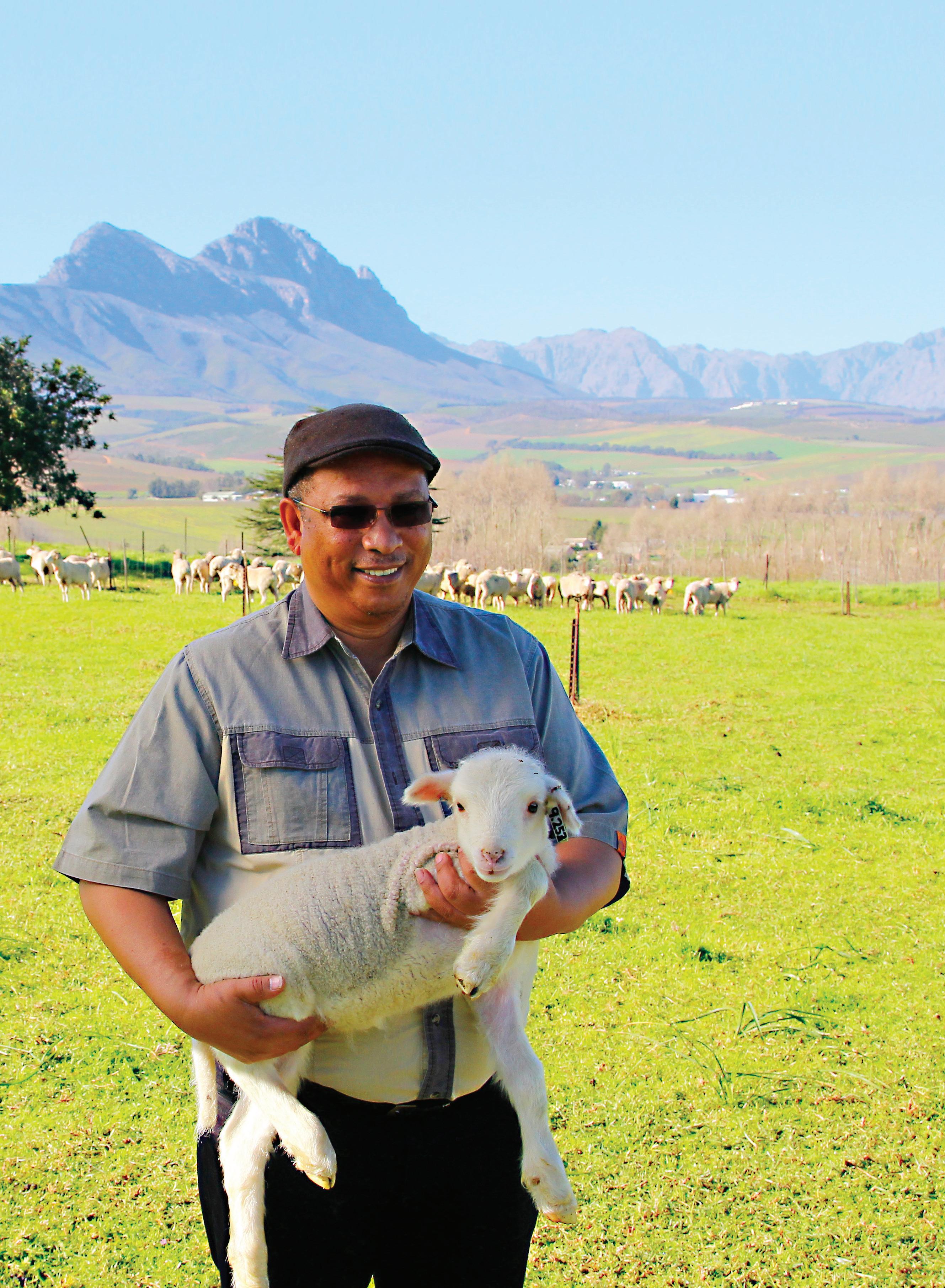



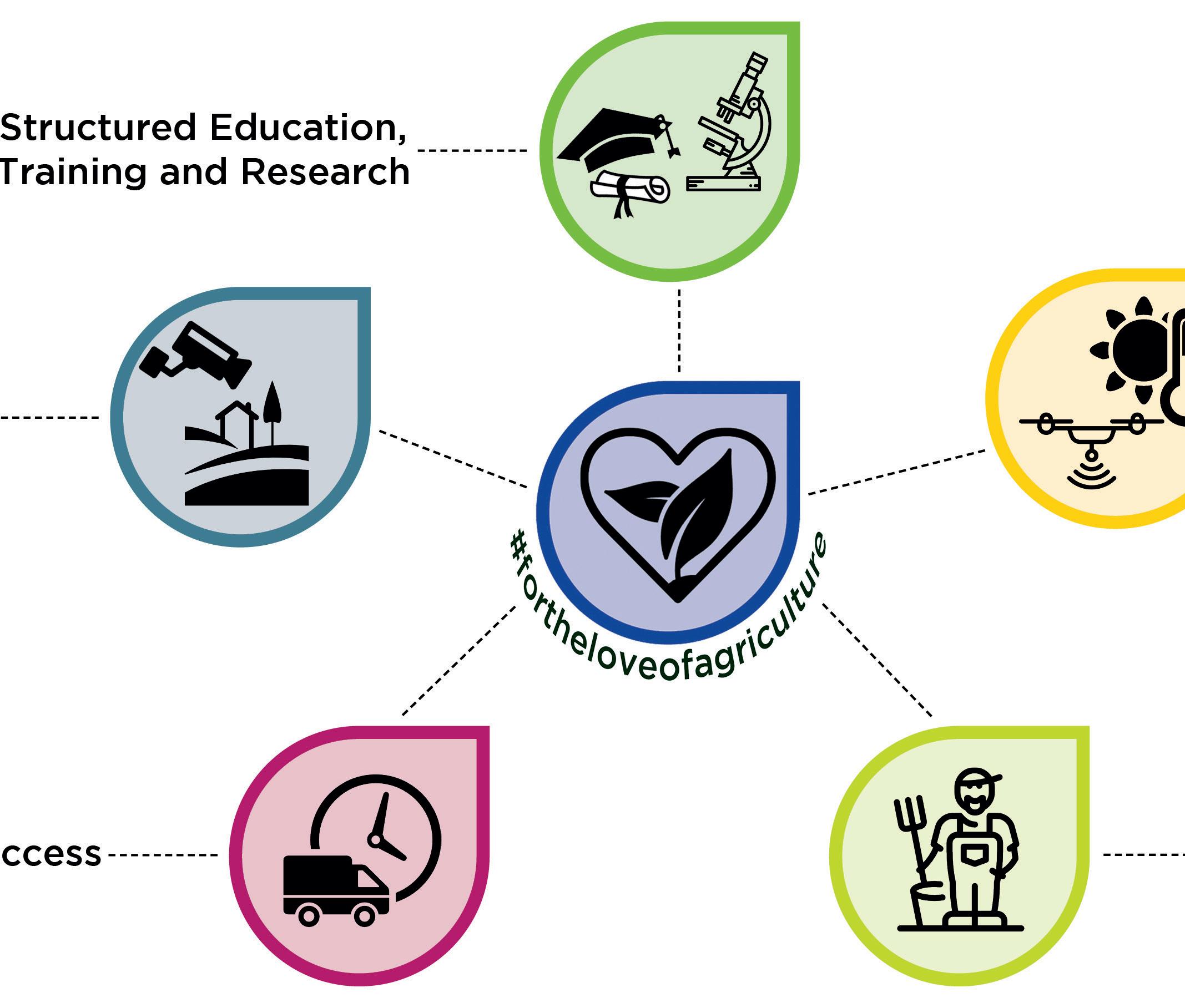
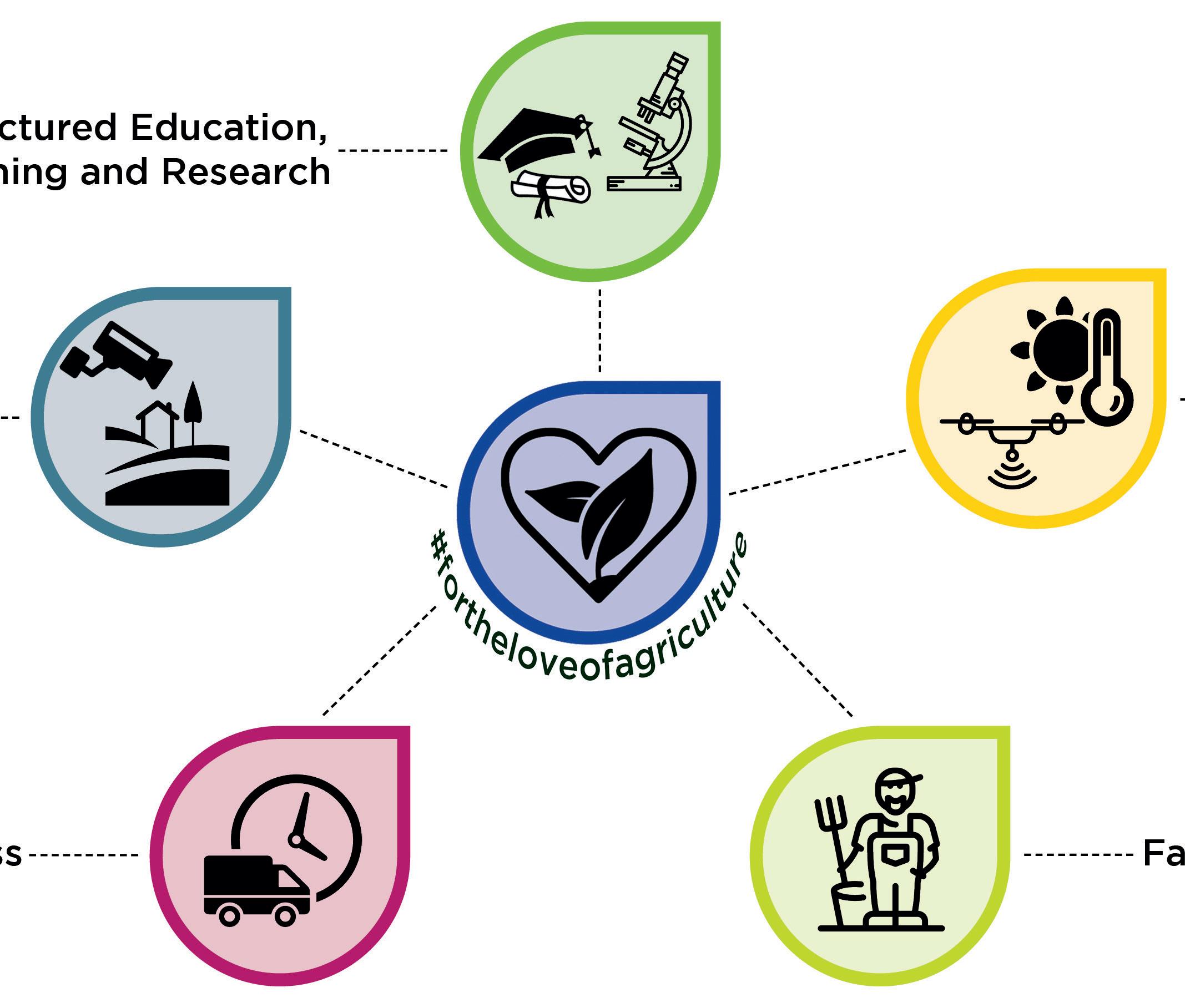
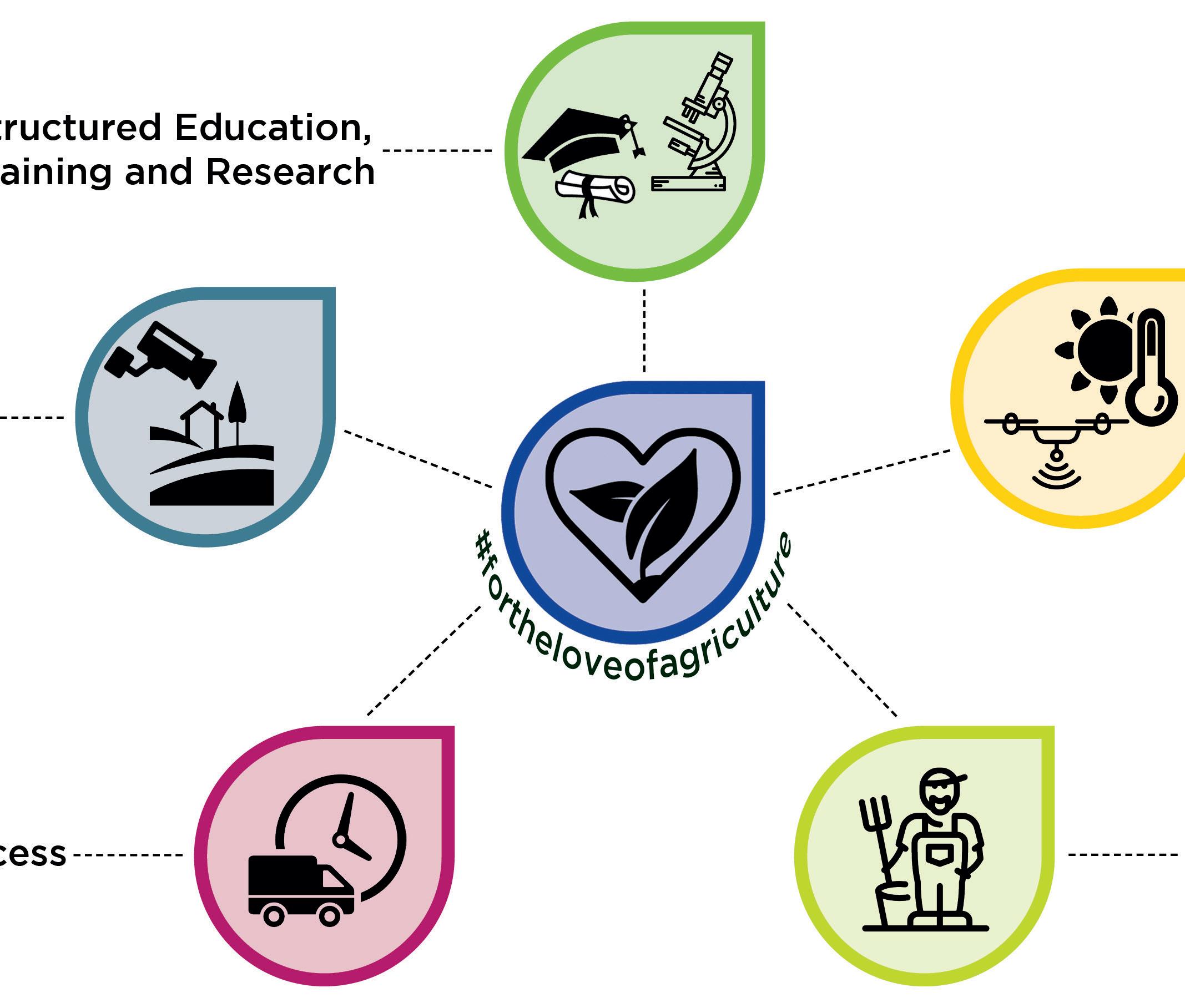
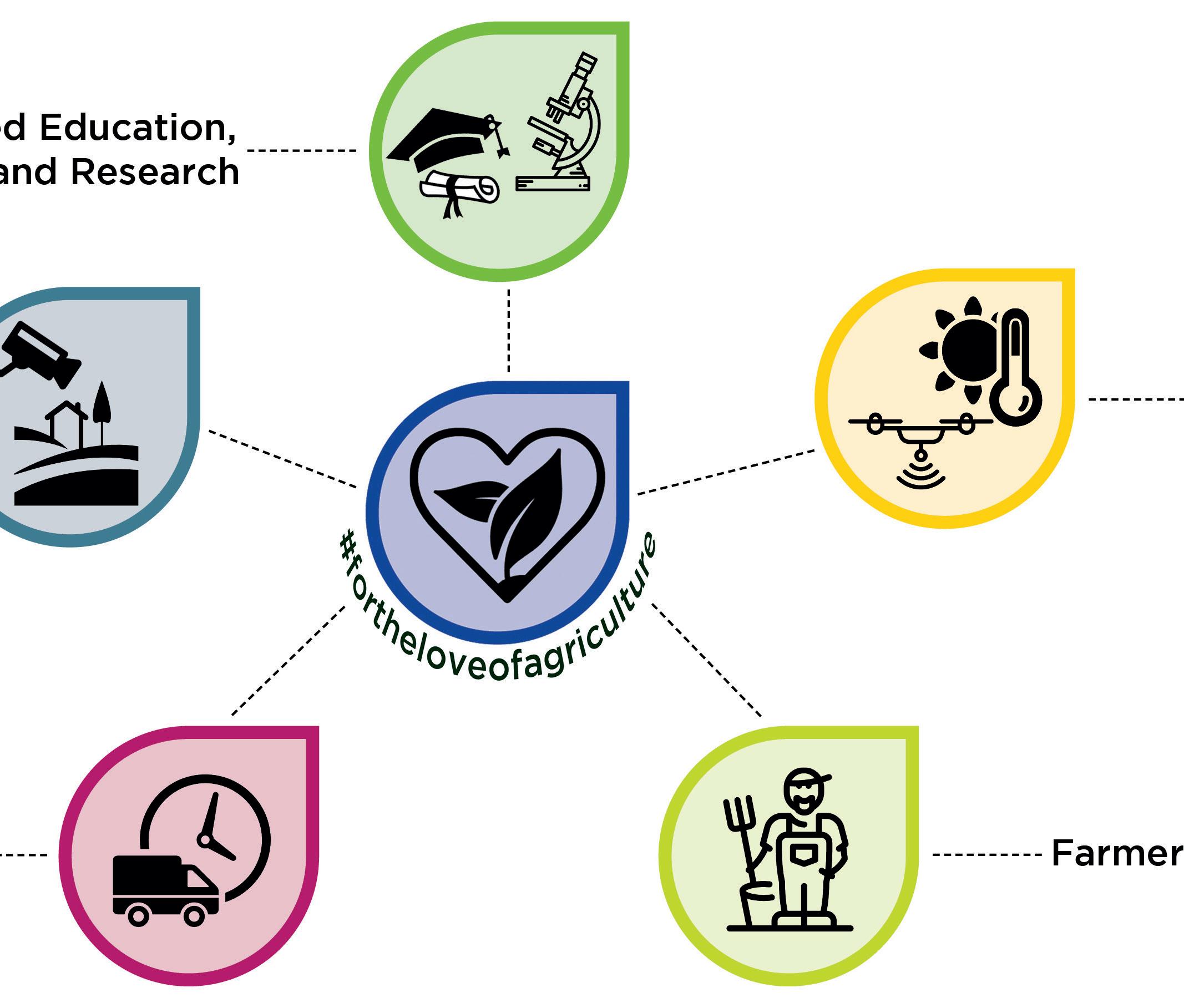
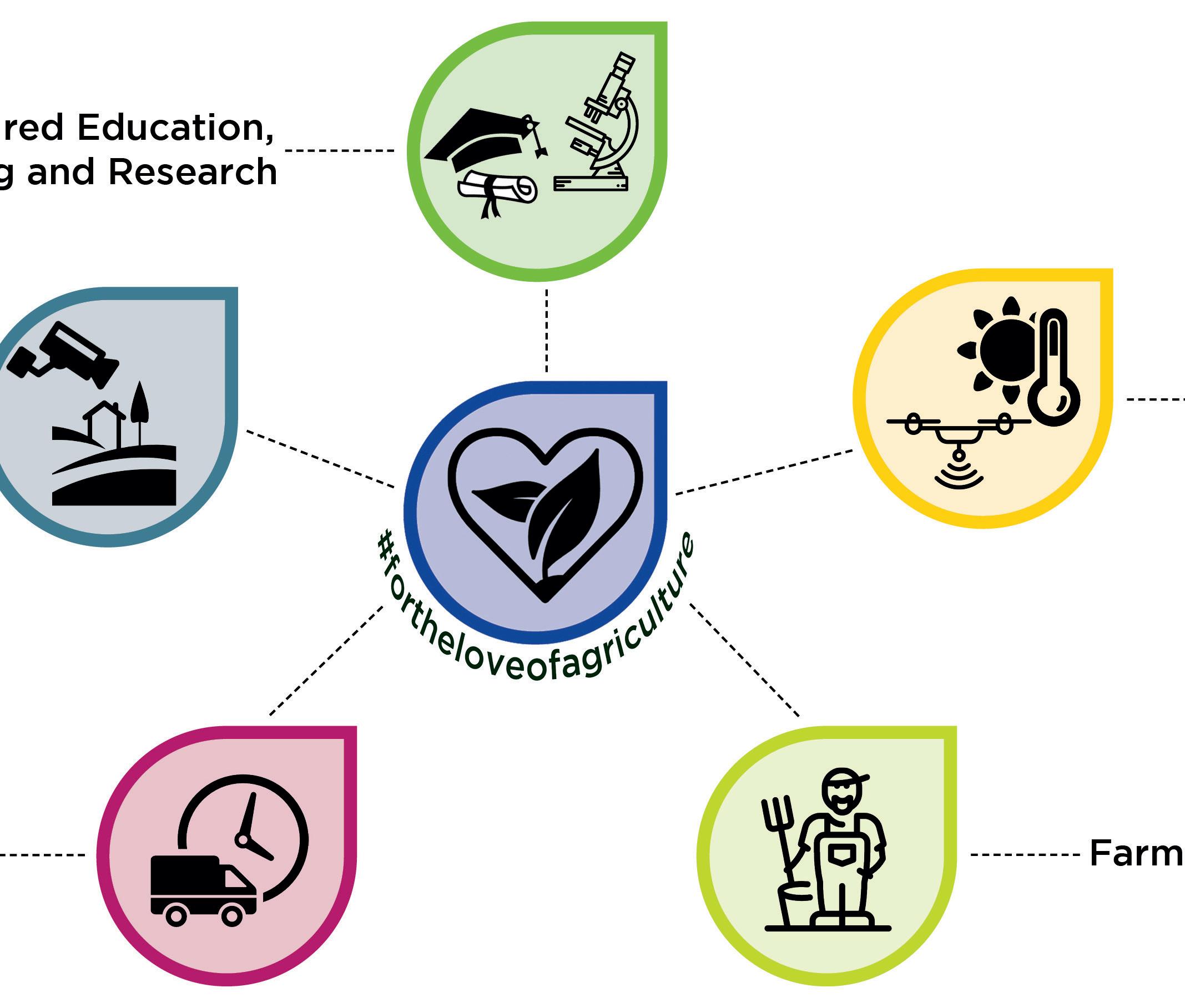










To help make the agricultural sector in the Western Cape grow and flourish, requires human capacity to be expanded and marketed to attract more young entrants to a career in agriculture. This third issue of AgriProbe caters not only for our customer segments, stakeholders or partners, but could be useful for the proverbial man-inthe-street. To optimise the use of scarce resources, farm management decisions have to be made based on a process of “fit-forpurpose” continual learning and appropriate research of what works best for farmers, food security, and the environment.
The heart of AgriProbe consists of various accounts of worthwhile achievements, awards, stories, activities, and research
by Dr Harry Swatsonconducted by staff at the Western Cape Department of Agriculture. There is a good mix of articles, for instance a section on our committed, passionate, innovative and creative new Minister of Agriculture, the Hon. Dr Ivan Meyer who has a futuristic vision for agriculture. Another section captures the experiences of our agricultural graduate interns. For them the image of agriculture is positive, and there are vast and exciting career opportunities as a result of emerging global and technological trends. The Fourth Industrial Revolution in agriculture is unfolding at an unprecedented pace. The Elsenburg College has been recognised as a highly valued agent to accelerate marketdriven Specific, Measurable, Achievable, Relevant, and Time-oriented (SMART) skills development in the Western Cape. The passionate and dedicated new Chief Director was welcomed to join the Elsenburg College team to meet this challenge. It is not possible within the limitations of AgriProbe to attempt to acknowledge all contributions from our stakeholders, partners and authors. We are truly grateful to you all for your meaningful and comprehensive inputs. Your skills, knowledge and collective experience have made this edition the best one yet.
Additionally, to our readers, enjoy this edition and join us as we celebrate the sector and its hard work and dedication.

EDITOR
Mary James (021 808 5008) maryj@elsenburg.com
CHAIRPERSON
Dr Ilse Trautmann (021 808 5012) ilset@elsenburg.com


SECRETARIAT
Gizelle van Wyk (021 808 5022) gizellevw@elsenburg.com
EDITORIAL COMMITTEE
Ashia Petersen ashiap@elsenburg.com
Douglas Chitepo (021 808 5100) douglasc@elsenburg.com
Riaan Nowers (021 808 5194) riaann@elsenburg.com
Maritjie Cornelissen (021 808 5497) maritjiec@elsenburg.com
Brighton Shumba (021 808 5384) brightons@elsenburg.com
Pavarni Jorgensen (021 808 5227) pavarnij@elsenburg.com
Dr Lesley van Helden (021 808 5107) lesleyvh@elsenburg.com
John Constable (021 808 7763) johnconstable@elsenburg.com
Arie van Ravenswaay (021 808 5085) arievr@elsenburg.com
Daniel Johnson (021 483 3261) Daniel.Johnson@westerncape.gov.za



Dr Ivan Meyer, Minister of Agriculture, is finally “home.” His enthusiasm is contagious, with his hands on approach, he’s taking agriculture forward with practical and sector-related priorities, paving the way for the next five years. The future looks bright for agriculture in the Western Cape. #ForTheLoveOfAgriculture


Project leader: Henk Odendaal Manager: Leza Putter Lead designer: Michélle van der Walt Copy editor: Michele van Loggerenberg

The first thing I did after my appointment as Western Cape Minister of Agriculture was to contact former Minister of Agriculture, Gerrit van Rensburg. I did so because I had served with him in the Western Cape Cabinet. During this period, I learnt a lot from “Oom Gerrit” (as he is affectionately known), now

happily retired in Mossel Bay, Southern Cape.
The next thing I did was create the hashtag, #ForTheLoveOfAgriculture, as I want South Africans to start loving and respecting agriculture.
It was US President Harry Truman who once said: “Prosperous farmers make a prosperous nation, and when farmers are in trouble, the nation is in trouble.”
These are profound words and very relevant to us in South Africa. I want farmers and agriculture in the Western Cape to prosper because I want South Africa to prosper.
Agriculture contributes 10% of the Western Cape’s GDP and makes up 17% of the Western Cape’s labour force. It also generates R21 billion in income annually.
After meeting departmental officials at Elsenburg, I crafted my priorities for agriculture in the Western Cape for the next five years. These are as follows:
• Continue and enhance structural training and agricultural education and research
• Strengthen support to commercial and emerging farmers
• Promote rural safety and rural development
• Create global market access for our agriproducts
• Utilise innovation, partnership and technology to deal with the challenges of climate change.
I also feel that we must have more agricultural schools in the Western Cape. We currently have three. This should be increased to one agricultural school per district.
We must make agriculture more “sexy” to attract more youth. I noticed at the recent African Youth Agripreneur Forum 2019 (#AYAF2019) conference that youth are taking up agriculture as a career.
I am also excited about the many women
involved in leadership in my department and in agricultural practice. Women in agriculture are to be found at all levels of the agricultural value chain. My own HOD, Ms Joyene Isaacs, is considered to be one of the best agricultural heads of department in South Africa. Women are leading in agriculture.
I am equally excited about the programmes at the Elsenburg College, the department’s human capital development strategy, youth opportunities and our veterinary services. World-class research in both animal and plant sciences is important to the department. Support for both commercial and smallscale farmers is valued in the Western Cape.
I am extremely proud that the SmartAgri plan of the department was recently awarded with the Eco-Logic 2019 gold award in the category “Climate Change”. It is an acknowledgement of this department’s contribution to ensure the sustainability of our sector.
Drought support and technical agricultural engineering services are crucial for survival during long periods of drought.
Economic growth and job creation are the key priorities of the next government and agriculture and agri-processing will be key players in this regard. Together with Wesgro, I am keen to take our agri-products to all the corners of the globe: Better Together.
Diets vary greatly from place to place based on food availability, eating habits, and culture. Yet, there is a general consensus on what is good or bad for us, no matter where we live. Here is a list of simple actions to help you make healthy eating and #ZeroHunger a way of life.
Eat plenty of fresh and ripe seasonal vegetables and fruit daily and add more legumes, nuts, and whole grains to your diet. These are great sources of plant-based protein and are normally cheaper than animal proteins. Also try to eat fish once or twice a week.
Cut back on foods that are high in refined starches, sugar, fats, and salt, and limit the intake of processed foods, meat, and other animal-source products. Whenever you can, switch refined starches like white rice, flour, and bread for brown and healthier equivalents.
While unsaturated fats (found in fish, nuts, sunflower, soya bean, canola and olive oils) are part of a healthy diet, you need to watch your intake of industrially produced trans-fats found in fried foods, doughnuts, crackers and biscuits, among others. We also need to limit the amount of saturated fats we consume (found in fatty meat, butter, palm and coconut oil, cream, cheese, ghee, and lard).
Consider the environmental impact of the foods you eat. Highly processed foods and
meat require a significant amount of water to produce. Try replacing one meat meal a week with another source of protein or an all-veggie meal. Avoid buying foods that have excessive packaging.
Diversify your diet by adding traditional, locally grown and seasonal foods, in an effort to support biodiversity.
Read labels and identify the ingredients that you should avoid. Be a critical consumer and do not let packaging sway you. Pay attention to the nutritious value of food. Note common words like ”zero”, ”low in”, and ”light”. They are used to make food sound healthier, but it is not always true…
In most cultures, meals are enjoyed with family and friends. Today, many of us spend too little time preparing meals due to busy lifestyles and we rely increasingly on street food vendors, supermarkets, fast-food outlets, or take-away restaurants. Eating in company is important for our health and the health of our children. Researchers have linked this with lower rates of obesity and eating disorders in children and adolescents, and general wellbeing.
Food connects us all. Help people reconnect with food for a #ZeroHunger lifestyle. For example, grow your own food at home, participate in a community garden or organise dinners with friends. AP


 by Giselle Terblanche, gisellet@elsenburg.com
by Giselle Terblanche, gisellet@elsenburg.com
Elsenburg Agricultural Training Institute (EATI) opens its doors to prospective students and their parents a few times a year. It provides them with the opportunity to experience the college and its courses at first hand and, in doing so, make informed decisions about what they want to study.

At the most recent event, visitors had the chance to learn more about the various faculties and meet lecturers by visiting the various exhibitions. They were also taken on a tour of the campus to view the different buildings and facilities.
The newly appointed Minister of Agriculture, Dr Ivan Meyer, was the guest

of honour. He thanked prospective students for wanting to contribute to the important role agriculture plays in the economy. He urged them to be committed to ensure food security, should they decide to join the sector, and to assist in finding solutions for the water crisis and other challenges facing agriculture. Minister Meyer praised the institution and said that students are in good hands with the “professional, dedicated and committed EATI staff.”
Maritjie Cornelissen, who organised the event, said the day was a huge success and of great value to visitors. She added that it was a team effort by the staff and student representative council (SRC).
For more information on the next campus tour, please contact Maritjie Cornelissen at maritjiec@elsenburg.com.
Compassion fatigue is common among animal workers, particularly those in the animal welfare field. However, with the needs of the animals being placed first, this is usually not attended to and the morale of animal welfare workers suffers accordingly. State veterinary office Oudtshoorn organised a workshop targeting animal workers, particularly animal workers from various welfare organisations.

The attendees ranged from SPCA staff as far as Mossel Bay, Garden Route, George PDSA, Oudtshoorn welfare volunteers, Animal Care Team SA (ACT SA), Oudtshoorn and Ladismith animal health technicians, Oudtshoorn pound workers, a Barrydale welfare worker and Calitzdorp animal welfare volunteers.
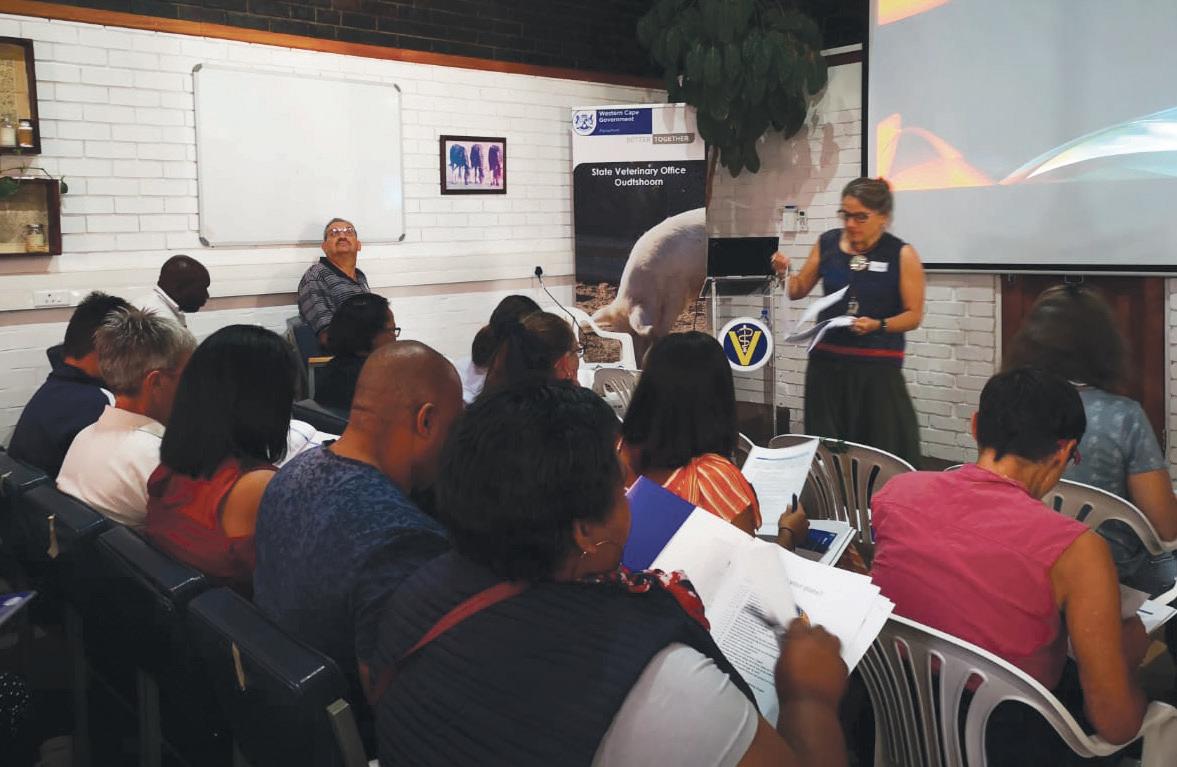
The workshop included a presentation on compassion fatigue – the signs, causes and treatment – by therapist Gisela Hoyle. Other topics covered were aggression in dogs and how to handle it. This was presented by a local dog trainer, Loraine Weldon. A talk on zoonoses commonly found in animal workers was also presented by compulsory community service (CCS) veterinarian Dr Juanita Jacobs. The Family and Marriage Society of South Africa (FAMSA) Karoo was also part of the day and workers were informed of the free counselling services provided for those who needed trauma counselling.
The attendees received a free goodie pack and also enjoyed a wonderful sponsored meal to end off the day.
 by Adéle Isaacs-Cloete, adelei@elsenburg.com
by Adéle Isaacs-Cloete, adelei@elsenburg.com
The Department of Agriculture, Forestry and Fisheries recognised young top performers in the industry at the Youth in Agriculture, Forestry and Fisheries (#YAFF) award ceremony in Port Elizabeth in July 2019. This is an incentivising platform that seeks to recognise youth excellence in the sector nationally. One of the requirements was that entrants must have been involved in agriculture, forestry and fisheries activities for a minimum of two years on a full-time basis and must be between 18 and 35 years of age, from previously disadvantaged backgrounds.

The theme for 2019 was “Reshaping the future of the agriculture, forestry and fisheries sectors by creating a sustainable
path for the country’s young producers”.
Mr Wayne Mansfield of Fruitfield farming in Paarl, Western Cape, received the commercial agriculture award for his exceptional achievement. Wayne started as a fruit seller who procured second-grade fruit from farmers in the area for resale through informal channels. He is now leasing land to produce lemons for both the domestic and export markets. Wayne is working closely with the Department of Agriculture through regular updates and visits.
The Western Cape Department of Agriculture is extremely proud of his achievement and commitment to the agricultural sector.
During the 2019 South African Cheese Festival held recently, it was “cooking” in the Cape Made Kitchen. The new Cape Made Recipe Book 2019 was launched with mouth-watering recipes, meticulously developed by the young chefs of The Private Hotel School. The purpose? To showcase the use of alternative crops in the kitchen.

It can take a persimmon tree up to seven years to produce fruit, and a persimmon tree can reach a height of over 20 metres tall.
12 servings
Persimmon flesh can be whipped into foam, thanks to its tannins, which help bind fragments of cell walls together and stabilise the air pockets.



250 g mixed nuts
60 g brown sugar
45 g butter, melted
500 mℓ pureed persimmons (fresh or rehydrated dried persimmons)
750 g cream cheese, softened
280 g white sugar
200 mℓ sour cream
2,5 mℓ ground cinnamon

2,5 mℓ ground ginger
6 eggs
TOPPING
200 mℓ sour cream
15 mℓ white sugar
Preheat the oven to 170 °C.
Combine the nuts, brown sugar, and melted butter in a food processor, and blend until fine.
Press the mixture into a 20 cm springform pan.
Bake for 12 minutes.
Set the crust aside to cool completely.
Combine the persimmon puree, cream cheese, sugar, sour cream, cinnamon, and ginger in the bowl of a stand mixer.
Mix until smooth.
Add the eggs, one at a time, and mix until fully incorporated.
Pour the mixture over the cooled crust.
Bake in the oven until almost set; for about an hour.
Leave the baked cheesecake to cool in the oven.
Combine the sugar and sour cream. When completely cool, top the cheesecake with the sour cream topping and walnuts.

 by Giselle Terblanche, gisellet@elsenburg.com
by Giselle Terblanche, gisellet@elsenburg.com
Anew Chief Director has recently taken over the helm at Elsenburg Agricultural Training Institute (EATI).
Hayley Rodkin is the extremely knowledgeable and skilled new principal who wants to lead EATI to new heights through platforms such as e-learning, drone training and other technological innovations. She is someone who knows exactly what she wants and how to get it done. AgriProbe paid her a visit to get to know her better.

I completed a Bachelor of Arts in English at UCT, an honours degree in literature at UNISA and a master’s degree in environmental management at UCT. In April, I received my second master’s degree – in creative writing (cum laude) from UWC.
Most recently I worked for the Department of Trade and Industry where I was the chief director for strategy management and public entity oversight. Prior to that, I worked at the Economic Development Department and the Department of Water Affairs.
I left the Western Cape in March 2000 for Pretoria, but I am happy to now return to this beautiful environment, which is of world class standard. I am passionate about social and ecological issues and hope to use my education and acquired knowledge to contribute to an integrated learning environment at Elsenburg. I believe that agricultural activities can serve as a catalyst for economic growth, job creation, and the overall well-being of our country.
The opportunity came along unexpectedly and I am embracing it because I believe in lifelong personal growth. Learning is a two-way process; as much as I can contribute to the department, I can simultaneously learn from the students and my colleagues, in order to build on what has already been accomplished at Elsenburg.
What is your impression of the WCDoA thus far?
I think that the department is vibrant and multi-faceted. It has a rich culture of endeavour, with a strong emphasis on community involvement, enrichment and empowerment. There is a healthy synergy between the department and the college, to provide the best experiential learning experience. From the executive management there is strong support and an emphasis on the role that education plays in the agricultural sector, for both informal and higher academic initiatives.
What is your vision for the college? What would you like to achieve?

I will strive towards taking existing programmes to new heights through platforms such as e-learning, drone training and other technological innovations. I would encourage our campus community to embrace the Fourth Industrial Revolution and its new scientific research.
What message would you like to give to college staff and to students?
I would like to encourage my staff to be the best public servants they can be and to build on their knowledge and creativity. To students, my advice is to cherish the multi-faceted opportunities provided to grow as agriculturalists and in so doing, play a pivotal role in our diverse society.
What makes you happy?
A vibrant society where individuals have access to fulfilling livelihoods, social security and active citizenship.
What is your favourite quote?
Carpe diem! (Seize the day!)
What advice would you give to your 20-year-old self?
To stay focused and not sweat the small stuff.
If you could master one new skill in one hour, what would it be? I would like to learn how to build an energy-efficient house. AP
Rudi Swart, scientific technician at the Directorate Plant Sciences of the Research and Technology Development programme, stationed at the Worcester Veld Reserve, received his MSc in nature conservation from the Nelson Mandela University during its April graduation ceremony.

The title of his thesis was “Germination potential of seeds harvested at the Worcester Veld Reserve” under the supervision of Dr Anton Schmidt from the Nelson Mandela University, Dr SJ Milton-Dean, a research associate at the South African Environmental Observation Network (SAEON), and Mrs Nelmarié Saayman, rangeland scientist in the department.
Palatable plants are almost absent in large parts of the Karoo because of degradation. In an attempt to return palatable plants to the degraded rangelands and improve productivity, the seeds of these species are sown, but with disappointing results. The objectives of the study were to determine the following:
• The causes of pre-sowing mortality
• The effect of drying on seed germination
• The effect of planting depth on seed germination
• The effect of storage time on seed germination
The findings of the study show that while the viability of the seeds harvested for rangeland reseeding projects is quite low, the appropriate pre-treatment, seed age and planting depth of less than 10 mm will allow a significant increase in germination. This increase in germination should provide a greater chance of establishing plants in rangeland reseeding projects. AP
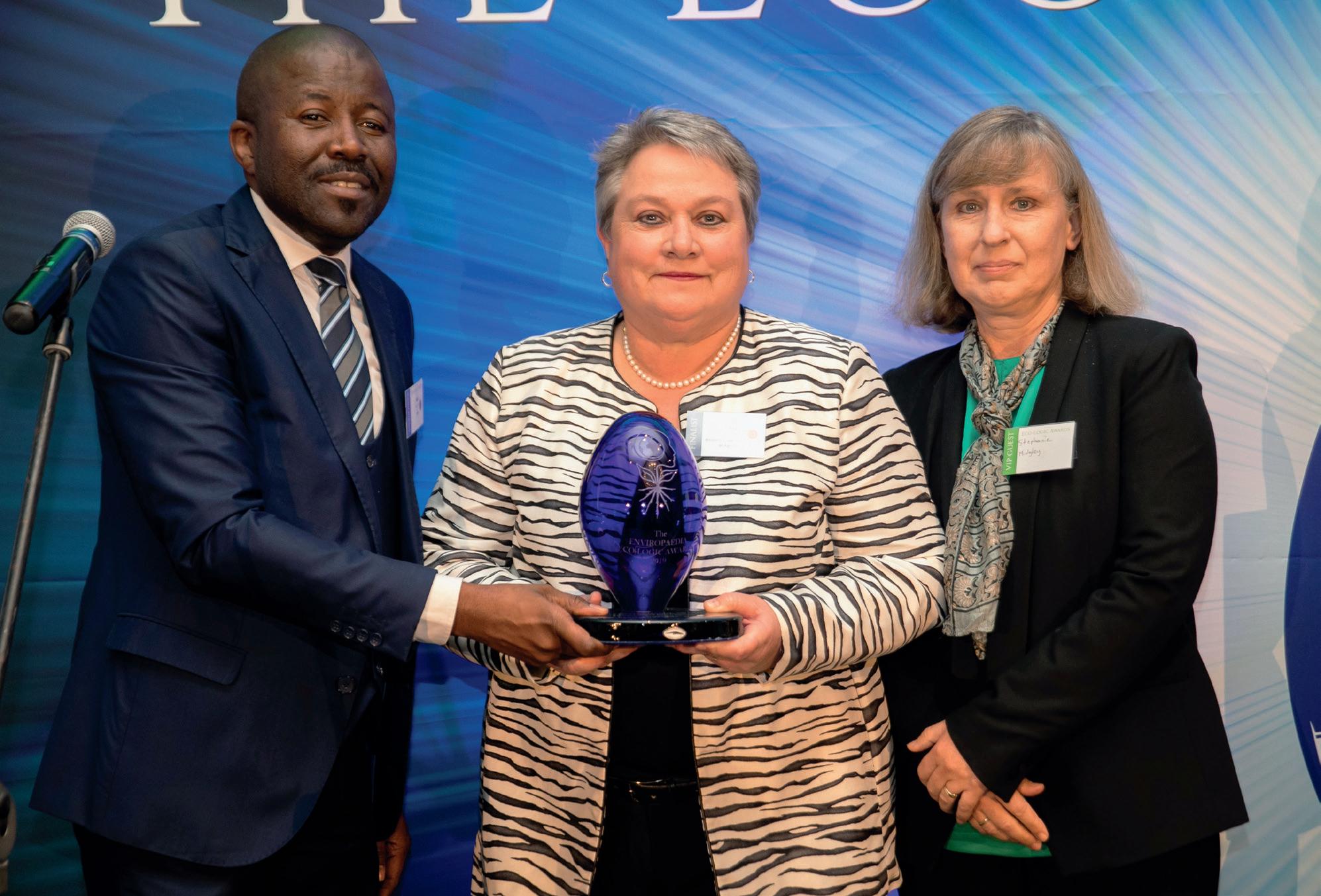 by Dr Ilse Trautmann, ilset@elsenburg.com
by Dr Ilse Trautmann, ilset@elsenburg.com
Shortly after being awarded the 2018 Premier Service Excellence gold award in the category “Best Implemented Plan”, the SmartAgri plan of the Department was awarded the Eco-Logic 2019 gold award in the category “Climate Change”, at a prestigious event held in Cape Town.
The Eco-Logic awards, an initiative of The Enviropaedia , identify individuals, organisations and communities that contribute positively towards a sustainable world and encourages consumers to support the finalists by purchasing their products and services. It was established in 2011 and draws entries from all over South Africa. These awards have since grown into South Africa’s most glamorous green eco calendar event, receiving extensive TV, radio, print media and online coverage.
The SmartAgri plan was completed in 2016 after an intensive twenty-month period where stakeholders involved in agriculture took part in co-writing the plan. It was a sterling example of “Better Together” with
the WCDoA as lead department. This was made possible with the assistance of the Department of Environmental Affairs and Development Planning, and after appointing the African Climate and Development Institute (ACDI) as expert climate change project leaders. The WCDoA is currently implementing the plan on departmental level, as well as on local government level and within the sector. Furthermore, the SmartAgri plan is a sector plan that is being implemented and communicated in such a way that it has become a household and sector name after clear and impactful branding.
After the recent droughts and other climate disasters in the province, it is evident that climate change is the “new normal” and the agricultural sector will have to adhere to climate-smart principles in order to be sustainable. Aided with the SmartAgri plan as a roadmap to resilience, agriculture in the Western Cape will prosper and jobs will increase and be secured in the future.
The adjudicators commented as follows at the winners’ announcement:
“SmartAgri (The Western Cape Climate Change Response Framework and Implementation Plan for the agricultural sector) is an outstanding example of how government has developed a plan and is implementing this plan for the benefit of all involved in the agricultural sector (including commercial and smallholder farmers, agriworkers, agribusinesses, etc.). The SmartAgri plan is also an attempt to secure the food basket of the Western Cape and beyond (regional, global exports, etc.), and to ensure that the agricultural sector in the Western Cape is more resilient against climate change, thereby securing jobs and ensuring economic development. SmartAgri is furthermore highlighting how difficult and comprehensive certain challenges are, in this case climate change, and finding effective ways to become more resilient as a sector. These action plans are delivered in a palatable and user-friendly way, in which the roles and responsibilities of stakeholders are clearly defined. The main aim is for stakeholders to pick up the plan, read it, get excited and move towards climate change resilience in their own way and at their own pace with their own tailor-made implementation plans. AP
 by Prof. Schalk Cloete, schalkc@elsenburg.com
by Prof. Schalk Cloete, schalkc@elsenburg.com
Scientific research on breeding often focuses on agricultural output traits as well as the improvement of productivity. Very often no attention is given to important input traits such as the resistance of animals to internal parasites, or traits driven by consumer preference such as ethical production practices to maximise animal welfare. Two postgraduate studies were undertaken at the Directorate Animal Sciences of the Research and Technology Development programme. They focused on the breeding of sheep for either an increased resistance to gastro-intestinal nematodes (GIN) or selection for temperament to enhance ethical production practices. It culminated in a PhD and an MSc being conferred during the autumn graduation ceremony of Stellenbosch University.
Dr Ziyanda Mpetile was promoted for a dissertation entitled “Genetics of ovine resistance to gastrointestinal nematodes”. Infestation with gastrointestinal nematodes (GIN) presents the local sheep industry with major challenges as these parasites have become resistant to conventional methods of chemical control as practiced over decades. To react to this challenge, the possibility of breeding sheep for resistance to GIN infestation was studied within and across breeds as a component of an integrated pest management strategy. Firstly, it was established that faecal worm egg count as proxy for resistance to GIN infestation was variable and heritable in replacement animals. It was also unrelated to important wool and liveweight traits in merino sheep. Season markedly affected the

magnitude of heritability estimates, the derived estimates being lower in autumn and higher in spring. Dormers were more resistant to infestation by GIN than South African mutton merino contemporaries, both as yearlings and as adult reproducing ewes. An across-flock study on merinos established that the variation attributed to the sire by location interaction was significant but contributed only about 2% of the available phenotypic variation. From this result, it was concluded that breeding values for faecal worm egg count would be fairly robust across environments and not prone to a marked re-ranking of sires across environments. Finally, the study proposed interventions to maximise
heritability estimates for faecal worm egg counts. The study also presented a strategy for including parasite resistance in the National Evaluation Scheme for sheep. No such service is available at present and such an intervention is likely to promote animal health as well as reducing the cost of production of grazing sheep under Mediterranean conditions.

Ms Marelee Burger received her MSc for a study entitled “Studies on the genetics of ovine behaviour in two Western Cape resource flocks aimed at improving animal welfare”. She reported results pertaining to the behaviour of a merino flock that was divergently selected for number of lambs weaned (NLW) per mating. Selection


resulted in two populations, namely the High line (H line, selected upwards) and the Low line (L line, selected downwards). H line lambs had shorter parturitions than L line lambs. This line difference also occurred in ewes. H line ewes had better maternal cooperation scores than L line ewes. H line ewes had an improved NLW compared to L line ewes while H line lambs had a better survival rate. Survival of lambs reared by surrogate dams in a multiple ovulation and embryo transfer study was accordingly higher in the H line than in the L line. Behavioural traits, lamb survival and NLW were heritable as ewe or lamb traits. Genetic trends suggested that parturitions were shorter in the H line and longer in the L line. Lamb survival was favourably correlated to length of parturition as lamb traits. Length of parturition and maternal cooperation score were also genetically favourable correlated to NLW analysed as ewe traits.
Animals from the H line came closer to a stationary human seated between the test animal and its flock mates and had fewer urination and defecation events than their L line contemporaries. These phenotypic line differences were confirmed by genetic trends. All arena traits were heritable. Selection for NLW promoted positive human–animal interactions, leading to an improvement in the welfare of ewes and lambs.

Both studies were among the most elaborate studies on these topics to date in South Africa and were supervised by Prof. Schalk Cloete and Prof. Kennedy Dzama. Dr Mpetile is now serving as a post-doctoral fellow at Fort Hare University while Ms Burger is employed as a data analyst at a local agrochemical company. Prof. Cloete has retired from the department as specialist scientist earlier this year and is continuing his research career as Extraordinary Professor at Stellenbosch University.

Very often no attention is given to important input traits such as the resistance of animals to internal parasites, or traits driven by consumer preference such as ethical production practices to maximise animal welfare.”Dr Mpetile (second from right) with Prof. Cloete (second from right) and Prof. Dzama (second from left). AP
 by Dr Harry Swatson, harrys@elsenburg.com
by Dr Harry Swatson, harrys@elsenburg.com
I, Dr Swatson, used to have a career master plan, which I updated regularly. After my BScHons in Agriculture I did a master’s degree in animal and poultry science and then a doctorate at the University of Natal. Thereafter, I was a post-doctoral fellow at the Centre for Rural Development at the University of Venda. The aim was to get the best job, support my resourcepoor family and community, contribute to the body of knowledge in agriculture and retire someday. But times have changed. For our graduates to survive today in the rapidly changing global village, they have to learn to manage a career and life in a changing workplace influenced by the Fourth Industrial Revolution. My advice to graduate interns in Agricultural Skills Development (ASD) is that there is no magic formula. If you have ambitions of reaching the top, then the best person to help you get there is you.
In 2018, the Western Cape Department of Agriculture in collaboration with various partners and stakeholders offered exciting opportunities for unemployed graduates through its Experiential Training, Internship and Professional Development Programme, which forms part of the comprehensive agricultural support programme (CASP). Graduates are appointed as interns for 24 months and undergo on-the-job agriculturerelated development training in technical, professional, public service, agribusiness and life skills experiential training and work experience. This enables them to either become “agri-entrepreneurs” or enter the formal agricultural job market anywhere along the value chain.
There are 15 graduates placed at ASD for experiential learning. They are placed in Oudtshoorn, Bredasdorp, Clanwilliam, and Elsenburg. Their qualifications range from diplomas to bachelor’s or master’s degrees in agriculture and agribusiness. Our initial misconception was that they do not have the required practical experience to perform
agricultural assignments on the farm. On the contrary, they have been fast learners. We now do not have to keep looking over their shoulders or interfere with their allocated practical tasks. Over the past 10 months their confidence, sense of responsibility and precision with executing practical tasks have grown tremendously. We are now able to trust the graduates with more demanding and responsible tasks.
For example, Sinethemba Sasanti, Bulelani, Masande Putuzo and Litha Zungula, who have qualifications in either agricultural management or horticulture, are placed at the agronomy section. Without much supervision they are able to effectively and efficiently manage commercial type tunnels from the growing phase to harvesting and post-harvesting of crops. These include tomatoes, cucumbers, egg plants and green peppers. They also have exposure to managing medicinal plants, including rooibos tea, moringa and lemon grass. Graduates also have reinforced their field crop management abilities for carrots, onions, pumpkins and beetroots. They are able to apply all the required soil preparation, disease prevention and control practices required for commercial crops. Graduates placed at the viticulture and animal production sections have also excelled in all allocated tasks. They are entrusted with more demanding tasks. For instance, Daine Fredericks, who holds a degree in horticulture and viticulture, had to:
• organise the drone awareness day;
• provide computer support for learnership students;
• participate in marketing the college programmes;
• facilitate learning events;
• do special tasks on rooibos tea; and
• organise farm visits.
Mr Lunga, placed at the viticulture farm section, had the added responsibility of professionally managing an aquarium.
I co-presented two papers with Tandile Buxeka at the 10th Extension Symposium on engaging stakeholders and capacity building to strengthen advisory services held from 17 to 19 July 2019 in Somerset West. It was a pleasant first time for the graduate intern and a great learning experience for both of us. All 15 graduates are ambitious and very keen to demonstrate their agricultural skills.
Graduates are encouraged to develop a carefully prepared professional portfolio to showcase their skills, experience and accomplishments. This will assist them to prepare for the world of work, enable them to evaluate their work and to reflect on their accomplishments, what others have to say about their performance, and what gaps there are in their professional experience. In order to establish their “professional net worth”, they are continually engaged in improving their practical agricultural skills and knowledge, strengthening their credentials, enhancing their reputation at work, and developing a network of professional contacts, while getting along with staff at all levels. Graduates have been provided with assessor, facilitator and moderator training. This will enable them to provide support for the ASD section. Other planned training interventions include recognition of prior learning (RPL), agroprocessing, farm business management and climate-smart agriculture workshops.
Result and method demonstration and study field trips to a rabbit farm, the Iqhude Farm in Elim, livestock farms in Oudtshoorn and in George are also planned.
An internal newsletter for ASD graduates only, captures graduate experiences and progress. This is managed by the Bredasdorp team Sivuyiseni Gatya and Ncebakazi Madletyana, who both hold a national diploma in agriculture. Graduates are encouraged to be visible through networking, attending conferences, workshops and seminars, writing for professional journals, and joining committees and task teams. This includes playing a major role in teams such as the following:
• Agricultural skills development
• The Fourth Industrial Revolution awareness interventions (applications of drones, robotics, artificial intelligence and Internet of Things (IoT) in agriculture along the entire value chain)
• RPL and e-learning task teams
• Aquaculture, apiculture, vermiculture and hydroponics curriculum review teams, among others

All graduates show interest in and dedication to the tasks assigned to them, and they build healthy relationships with other staff, supervisors and colleagues. The team is encouraged to point out the mistakes of graduates with diplomacy. Reflection on assigned tasks is taken in the spirit of support and at all times practical suggestions for improvement are provided. Staff members are encouraged never to condemn the interns for failing to live up to organisational culture and work expectations and not to show preference for one intern over another.
Leopards don’t change their spots, nor do entrepreneurs change their dreams, ambitions and decisiveness. Graduate interns must be visionaries and aim for success in all that they dream of. AP
RSG Landbou (RSG 100–104 FM) word Vrydae om 04:45 en Saterdae om 11:45 uitgesaai en word vervaardig deur die Wes-Kaapse Departement van Landbou. Op die Vrydagprogram help ons graag landbouers met tegniese raad en kennis komende van ’n wye verskeidenheid van kenners. Belangrike nuusgebeure word ook op hierdie inligtingsryke program bespreek. Tydens die Saterdagprogram deel ons stories van hoop en inspirasie oor die mense in die landbousektor. Kontak my, Eloise Pretorius, indien jy self ’n bydrae wil lewer, of indien jy weet van iemand wat kan, by eloisep@elsenburg.com
RSG Landbou is broadcasted on Fridays at 04:45 and Saturdays at 11:45 on RSG 100–104 FM, nationwide. This programme is produced by the Western Cape Department of Agriculture. On Fridays, the programme is filled with useful information from an array of experts with the aim to support and inform the agricultural community. Technical advice is given and newsworthy items are discussed. During the Saturday programme we share stories of hope and inspiration about the people in agriculture. Feel free to contact me, Eloise Pretorius, should you wish to make a contribution on RSG Landbou, at eloisep@elsenburg.com

Rural youth interventions have become one of the Rural Development Programme’s flagship projects boasting positive results in a short period of time. During the 2018/19 financial year, the project kicked off with localised interventions in all districts of the Western Cape. Each event was carefully planned and aligned to key data sources, which included the Agri Worker Household Census and very importantly, primary information collected via engagements with youth in these rural nodes. Collaborative efforts between the Rural Development Programme, the Municipality and the Council of Stakeholders culminated in tailor-made interventions addressing specific needs in the area. Common themes discussed included the following:
• Job readiness
• Substance abuse awareness
• Teenage pregnancy
• Funding options
• Career, bursary and internship options offered by the Department of Agriculture
• Consumer protection and the rights of consumers
After completing localised rural youth interventions, the project graduated to a
province-wide intervention where rural youths were selected to participate in a twoday intensive programme. The intervention took place at the Dunes in Arniston. The intention was to remove these individuals from their current everyday environments and to create a learning platform where rural youths from different areas would be able to exchange ideas and success stories. The two-day intervention took a deep dive into themes initially discussed at the localised interventions as well as new challenges identified as the process unfolded.
The 25 people attending the provincial intervention all left with:
• stationery packs enabling them to do very basic administration;
• CVs printed and stored on a memory stick supplied as part of the stationery pack;
• introduction on starting a business and selling your brand;
• job-readiness training;
• a basic computer literacy course; and
• substance abuse awareness training.
Mbali Mndaweni (Ebenhaeser) has established a catering company. She is one of the catering service providers for ISC meetings in the West Coast.
The youth intervention held in Lutzville
1. Group project.
2. Rural Youth Workshop in Ceres.


3. Provincial camp.
4. Substance abuse session.

made it possible for Dwayne Booysen to realise his dreams and start a career in agriculture. Our team from Elsenburg (RD and EDI) assisted Dwayne with the application process for enrolment at Elsenburg. He is an FET Learner in Plant Production: Viticulture at Elsenburg College.

Thandiswa Mokhuphi from Nduli has been empowered and enlightened by the motivational workshop sessions and has now become a motivational speaker in her community. Furthermore, she has used her CV compilation skills to assist a community
member to write a CV, which helped her to get employment.
Due to popular demand from all corners we will continue and further expand these interventions. The Rural Development Programme intends to expand on these successes given the learning and linkages that developed. For the 2019/20 financial year we plan to collaboratively implement five localised rural interventions and an intense provincial intervention.
 by Kamohelo Mathibeli, kamohelom@elsenburg.com; Babalo Mbuqe, babalom@elsenburg.com and Maliviwe Makeleni, maliviwem@elsenburg.com
by Kamohelo Mathibeli, kamohelom@elsenburg.com; Babalo Mbuqe, babalom@elsenburg.com and Maliviwe Makeleni, maliviwem@elsenburg.com
The Market Access Programme (MAP) of the Western Cape Department of Agriculture aims to strengthen the economic sustainability of black smallholder and commercial producers by addressing the upstream and downstream market access challenges across the value chain. This stems from the department’s mandate of enhancing

the competitiveness of the agricultural and agribusiness sector. Every year, the Market Access Programme, through its capacitybuilding and training sub-programme, which targets black commercial fruit farmers, provides support to farmers to attend a Market Access international study tour to the European Union (EU).
Fruit Logistica is an annual global exhibition that takes place in Berlin, Germany. This event is attended by various companies and entrepreneurs across the globe. The event encompasses every part of the fresh produce sector and creates a platform for businesses to establish new networks and business transaction. Businesses also get the opportunity to showcase new products and technologies within the fresh produce industry. The event is therefore widely known as a seedbed for innovation and partnerships within the sector. On average, approximately 3 200 exhibitors and 78 000 trade visitors attend the event annually to realise business potential from various regions within the global fresh produce supply chain.
As part of the Market Access study tour to Europe, the participating farmers firstly visit the Netherlands for about two days before actually proceeding to Germany for the Fruit Logistica exhibition. During their tour in the Netherlands, the participants visit various components of the fruit logistics chain such as harbours, supermarkets and fruit farms with postharvest infrastructure. Such exposure gives participants an opportunity to gain a better understanding of the logistical chains and business practices in the EU as well as learning innovative ways of matching their
exportable products with the requirements of EU markets. In addition, the tour enables participants to improve their skills, knowledge and experience in designing and implementing their product-specific export market plans. It is also expected that participants share this knowledge and their experiences with colleagues and/or co-owners in their businesses.


The Market Access Programme began providing support to farmers to attend Fruit Logistica study tours in 2007. The programme supported 10 farmers during its inception in 2007. More than 80 farmers have been supported in the past 12 years.
Wayne Mansfield, the owner of Fruitfield farming based in Paarl, pointed out that “attending the show was an eye-opener for me to see how agricultural entrepreneurs and other relevant stakeholders interact and operate at an international level”.

To establish new business relationships and strengthen existing ones were the key business drivers that he learnt about by participating in the event. He added that “visiting an apple farm in Amsterdam gave me a new experience of how other farmers around the globe operate”. This visit also taught him about cost-saving techniques at farm level, among other aspects.
Ms Marilyn Siegels, a farm manager at Protea Farm in Grabouw, expressed her gratitude to the Western Cape Department of Agriculture for providing them the opportunity to attend the event. “This event gave me a new perspective and ideas on how emerging black farmers can succeed if they are to work together as a team”, she said. Jan van der Merwe, a farm manager at Kaapchon Boerdery, also highlighted that the event helped him to understand the entire value chain of fruit from the farm level until it reaches the global market.
Overall, the exposure of fruit farmers to international events such as Fruit Logistica is a great opportunity for them to understand that they are competing with global farmers and what new innovations and technologies currently exist within the global fruit industry. It also enables them to land new business deals with international marketers. This platform assists South African fruit farmers/ exporters to better understand what is required by international clients in terms of quality, minimum residue levels (MRLs), packaging, and the compliance standards required in order to supply those markets competitively and sustainably.




























































Fruit Logistica is widely known as a seedbed for innovation and partnership within the global fruit industry.”
The Western Cape Agricultural Sector Profile is an annual publication developed by the Agricultural Economics Services Programme of the Western Cape Department of Agriculture. It provides a comprehensive and up-to-date overview of the Western Cape agricultural sector and highlights key trends shaping the sector, analysing them in the context of the current economic and policy climate.
The 2018 publication was the first since the project’s inception and shows a sector in recovery after various natural disasters seriously impacted agricultural investment and production. Investment in the Western Cape’s agriculture, forestry and fisheries
sector has declined in real terms from R4,6 billion in 2007 (2017 prices) to R4,1 billion in 2017. Over this period the province’s contribution to the national economy also dropped slightly, but the Western Cape’s gross value added (GVA) was still growing steadily in real terms from R497 billion in 2007 to R567 billion in 2017. The three biggest economic sectors contributing to GVA are business services, trade and hospitality, and manufacturing. Agriculture’s contribution currently accounts for 3,9% of the provincial economy and employs 17% of the entire labour force in the province.
A new freely available resource, annually updated and rich in information.”
The West Coast and Cape Winelands districts account for approximately 58% of the Western Cape’s agricultural GVA. The bulk of forestry value added is from the Eden district, while the city of Cape Town alone accounts for 60% of food and 64% of beverages and tobacco GVA. In terms of land use, the recently completed flyover project reveals that of the total crops planted, 69% was grains and oilseeds, followed by vegetables (10%), orchards (9%) and tea and hops (3%). The major crops produced in the province in terms of area planted are wheat, wine grapes, canola and barley. At national level, the Western Cape agricultural

output is quite substantial compared to other provinces.
In terms of trade the province has exhibited a real increase in the trade balance over the past decade, from R18 billion in 2007 to R21 billion in 2017. The domestic market has also responded positively in the form of increased demand for agricultural production as the number of households has increased as the population has grown. However, much still needs to be done to address a 3% increase in the number of households experiencing adult hunger, and a 1,5% increase in those that experience child hunger over the ten-year period.
Gains in agricultural employment until 2015 have been eroded somewhat in the face of the recent drought. This can be seen in a significant decline in seasonally adjusted provincial employment in the Western Cape’s agricultural, forestry and fisheries sector. By the end of 2015 employment in the sector totalled 232 319, but this fell to 187 044 by the end of 2017. The gains made prior to the drought should be highlighted because despite this
contraction, employment still stands higher than prior to 2015.
Despite the obvious challenges there are definite signs that the Western Cape agricultural sector is on a recovery path towards prosperity. The information here is just a tiny snippet of what has transpired, but the department’s new Sector Profile will ensure that all stakeholders are able to access an information source that covers a much larger part of the picture.
If you would like to receive the 2018 Western Cape Agricultural Sector Profile, and/or would like to be added to the mailing list to receive the 2019 Sector Profile once it is completed, please email Andrew Partridge (andrewp@elsenburg.com) or Tshepo Morokong (tshepom@elsenburg.com).

In May 2019, the Western Cape Government convened one of the largest business seminars to date celebrating Africa Day on 24 May 2019. This event at the Mazars Hotel (Century City) drew the attention of 170 delegates, representing local and international communities involved in agribusiness and trade, academia, government and African consuls general. Delegates took turns to reflect on some of the deep-rooted challenges confronting the continent and committed to adopt new pathways to overcome them through regional integration. Many embraced the recently signed agreement establishing the African Continental Free Trade Area (AfCFTA), which came into force on 30 May 2019, as a major stepping stone towards regional integration. The Business Seminar was also welcomed as an invaluable platform for promoting and enhancing multi-stakeholder trade policy advocacy and dialogue.
The AfCFTA comprises 55 member states of the African Union with an estimated market share of more than 1,2 billion people,
and a combined gross domestic product (GDP) of more than US$3,4 trillion.1 This free-trade area is the largest in the world in terms of participating countries since the formation of the World Trade Organization. Estimates from the Economic Commission for Africa (UNECA) suggest that the AfCFTA has the potential to boost intra-African trade by 52,3% by the year 2022. This will be done through eliminating import duties and it is expected to double if nontariff barriers (NTB) are also reduced. 2 AfCFTA was crafted to expand intraAfrican trade through better harmonisation and coordination of trade liberalisation and facilitation and instruments across the continent. It is expected to enhance competitiveness at industry and enterprise level through exploitation of opportunities for scale production, continental market access, and better reallocation of resources.
Inasmuch as delegates embraced this AFCFTA agreement, it is clear that the achievement of objectives will not be easy. It was signed but not yet ratified by a sufficient number of countries. Furthermore,
only the framework agreement has been signed with negotiations on a number of matters still continuing. The predecessor to the AfCFTA, the Tripartite Free Trade Area (TFTA) (between SADC, COMESA and the East African Community [EAC]), which was signed and ratified, has not been implemented yet as negotiations on tariff reductions are still continuing. In fact, tariff barriers are considered the least of the challenges confronting inter-African trade. NTBs are the evil stepmothers. The cost of doing business, the cost of transport, bureaucratic delays and corruption at border posts and other latent practices that erode competitiveness are the major deterrents towards free trade in Africa.
Nevertheless, as Rome was not built in one day, why do we expect the road from Cape to Cairo to be built (and paved) in a year? With these challenges in mind, the keynote speaker Mr Solly Fourie challenged member states to remove the red tape and install a red carpet to create an enabling environment for all to utilise “energy within”, and for foreign investors to enter a level playing field to compete on. This red-tapeto-red-carpet-narrative was further affirmed by Mr Neville Mandimika, a business analyst
for Africa in the Global Markets division at Rand Merchant Bank (RMB) under the theme “where to invest in Africa”. The RMB investment index cites countries such as Egypt, South Africa, Morocco, Ethiopia, Kenya, Rwanda, Tanzania, Nigeria, Ghana and Côte d’Ivoire as the leading investment destinations in Africa. A summary of the investment index is presented on the diagram below.
The Industrial Development Corporation (IDC) pledged commitment towards investment projects in the rest of Africa and Wesgro, the official tourism, trade and investment promotion agency for Cape Town and the Western Cape, indicated that the value of the Western Cape’s exports to Africa is now higher than to Europe. These deliberations were an eye-opener to some of the local entrepreneurs and potential investors in attendance. Towards the end of the proceedings the message was crystal clear; there is a greater need for businesses to maximise the development potential of Africa. Sincere messages of gratitude were conveyed to the Western Cape Department of Agriculture, the Premier’s office and Wesgro, in partnership with Mazars House for sponsoring this event. AP
Die siekte beesbrusellose, wat beter bekend staan as besmetlike misgeboorte, is een van die groot bedreigings in beide ons vleis- en melkbeesbedrywe. Dit is nie alleen ’n siekte wat ’n negatiewe ekonomiese impak op landbou het nie, maar dit kan ook van die dier na die mens oorgedra word. Beesbrusellose veroorsaak
produksieverliese as gevolg van koeie wat aborteer en swak kalwers produseer. Besmette koeie wat kalf, steek dan ook die res van die kudde op ’n eksponensiële wyse aan, aangesien beeste nuuskierig van aard is en aan die besmette fetus ruik en lek. As gevolg van die ekonomiese impak van die siekte en die potensiaal om siekte by die mens te veroorsaak, word dit as ’n staatsbeheerde siekte geklassifiseer.

Daar is ook wetgewing wat vereis dat alle verse tussen die ouderdom van vier en agt maande met ’n doeltreffende entstof deur die persoon verantwoordelik vir die kudde geënt moet word.
Mense kan hoofsaaklik op drie maniere besmet raak:
• As daar met enige besmette materiaal soos nageboorte en fetusse in aanraking gekom word
• As ’n persoon homself met entstof sou raakspuit
• As ’n mens die ongepasteuriseerde melk van besmette koeie sou drink, wat die mees algemene rede is
Wanneer ’n mens met brucellose besmet raak, word dit wisselkoors genoem en die mees algemene simptoom is afwisselende koors, aldus die naam “wisselkoors”. Die siekte kom voor met baie nie-spesifieke simptome wat dit moeilik maak vir dokters om te diagnoseer. Simptome sluit onder andere ook nagsweet, rusteloosheid, depressie en gewrigspyn in. Wisselkoors is ook baie moeilik behandelbaar en is gewoonlik chronies van aard.
Die Veeartsenykundige Dienste-program van die Wes-Kaapse Departement Landbou is daartoe verbind om proaktief op te tree in die voorkoming en beheer van hierdie siekte. Die program het gevolglik onlangs in samewerking met hul vennote by MSD Dieregesondheid ’n brucellose inligtingsdag in Stormsvlei aangebied.

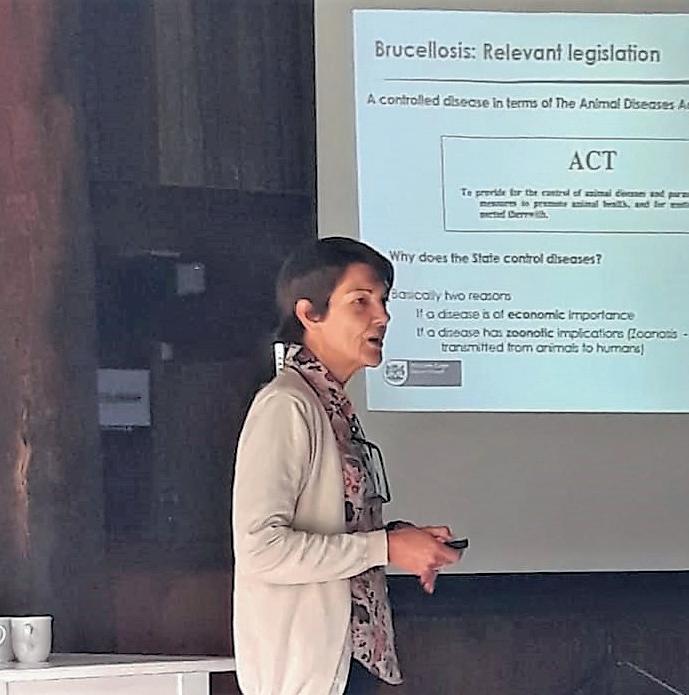
Alle belanghebbendes in die omgewing is genooi en die byeenkoms het ’n goeie opkoms gehad. Beesboere, veeartse, dieregesondheidstegnici, veterinêre tegnoloë en farmaseutiese verteenwoordigers van dwarsoor die Wes-Kaap het dit bygewoon.

Dr. Sewellyn Davey, voorsitter van die Brucellose-werkskomitee van die nasionale dieregesondheidsforum het die tegniese en regsaspekte van die siekte behartig.
Dr. Chriché du Plessis, herkouer entstofspesialis van MSD het op haar beurt die voorkoming en beheermaatreëls van beesbrusellose behandel. Gemeenskapsdiensjaar veearts, Dr. Maricia Schempers, het gesê “Dankie vir die byeenkoms; dit was ‘awesome’!” Hierdie is maar net een van die goeie terugvoere wat beklemtoon hoe groot die behoefte
vir alle belanghebbendes is om bymekaar te kom en om op ’n strategiese wyse ’n siekte soos hierdie te bestry.
Die huidige stand van beesbrusellose in Suid-Afrika is uiters kommerwekkend. Daar kan nie genoeg klem gelê word op hoe belangrik dit is dat alle rolspelers in die bedryf dit eens moet wees aangaande die effektiewe voorkoming en bestryding daarvan nie.
Getrou aan die etos van die WesKaapse regering, “Beter tesame”, glo die organiseerders van die geleentheid dat daar hande gevat moet word om beesbrusellose in sy spore te stuit. Inligtingsdae soos hierdie, waar die Wes-Kaapse regering, die bedryf en die handel almal saamwerk, is ’n reusestap in die regte rigting.

Daar is ook wetgewing wat vereis dat alle verse tussen die ouderdom van vier en agt maande met ’n doeltreffende entstof deur die persoon verantwoordelik vir die kudde geënt moet word.”
The Animal Care Team SA (ACT SA), a nonprofit organisation (NPO) for animals, with the assistance of the Oudtshoorn and George state veterinary offices, together with the Ebervet Petcare Group, De Rust Animal Clinic, SPCA Garden Route and Uniondale Pet Care, sterilised 130 animals (dogs and cats), in a resource-poor community on 24 and 25 April 2019 in Uniondale.
This joint outreach idea was born in late 2018 after the SPCA Garden Route brought the great need for veterinary assistance in the area to ACT SA’s attention. Uniondale is a small rural town of approximately 4 500 people and they have limited access to veterinary care. SPCA Garden
Route therefore has a monthly outreach programme in Uniondale and provides basic
care to all the animals in need. With no access to a sterilisation programme, animal welfare cannot be addressed fully and hence welfare groups initiated the idea of having a local “spayathon”. The lack of animals being sterilised leads to an uncontrolled increase in the animal population. This growing number of animals makes it difficult for the people of the community with limited financial resources to look after every single animal.
With SPCA screening and the assistance of Uniondale Pet Care, animals that needed to be sterilised were identified. A team of
six veterinarians, both private and from the state veterinary services, were brought together to assist in the very first two-day “spayathon” in Uniondale. The welfare teams, who played a major role in this gathering, consisted of ACT SA and SPCA Garden Route, Uniondale Pet Care and members of the Uniondale community, who also pitched in to help.
Animals were brought to the community hall by the people from the community or with the assistance of two SPCA inspectors. Two vet nurses, one from Ebervet Petcare

and another from SPCA Garden Route and animal health technicians, with the assistance of two ACT SA volunteers, were responsible for preparing the animals before sterilisation. This included sedation, shaving and washing of the surgical site, and placing the animal under general anaesthesia. A group of six veterinarians conducted the surgeries and post-operative care was given to the animals by three volunteers from ACT SA and two from Uniondale Pet Care. All the animals that were brought for sterilisation also received vaccinations, deworming and tick and flea treatment where necessary. A few cases
of bite wounds and lacerations were treated as well.
Among the group of vets who joined forces were three young recently qualified veterinarians doing their community service year in Oudtshoorn and George state veterinary offices. The “spayathon” was a great opportunity for them to learn from the older, more experienced veterinarians who participated.

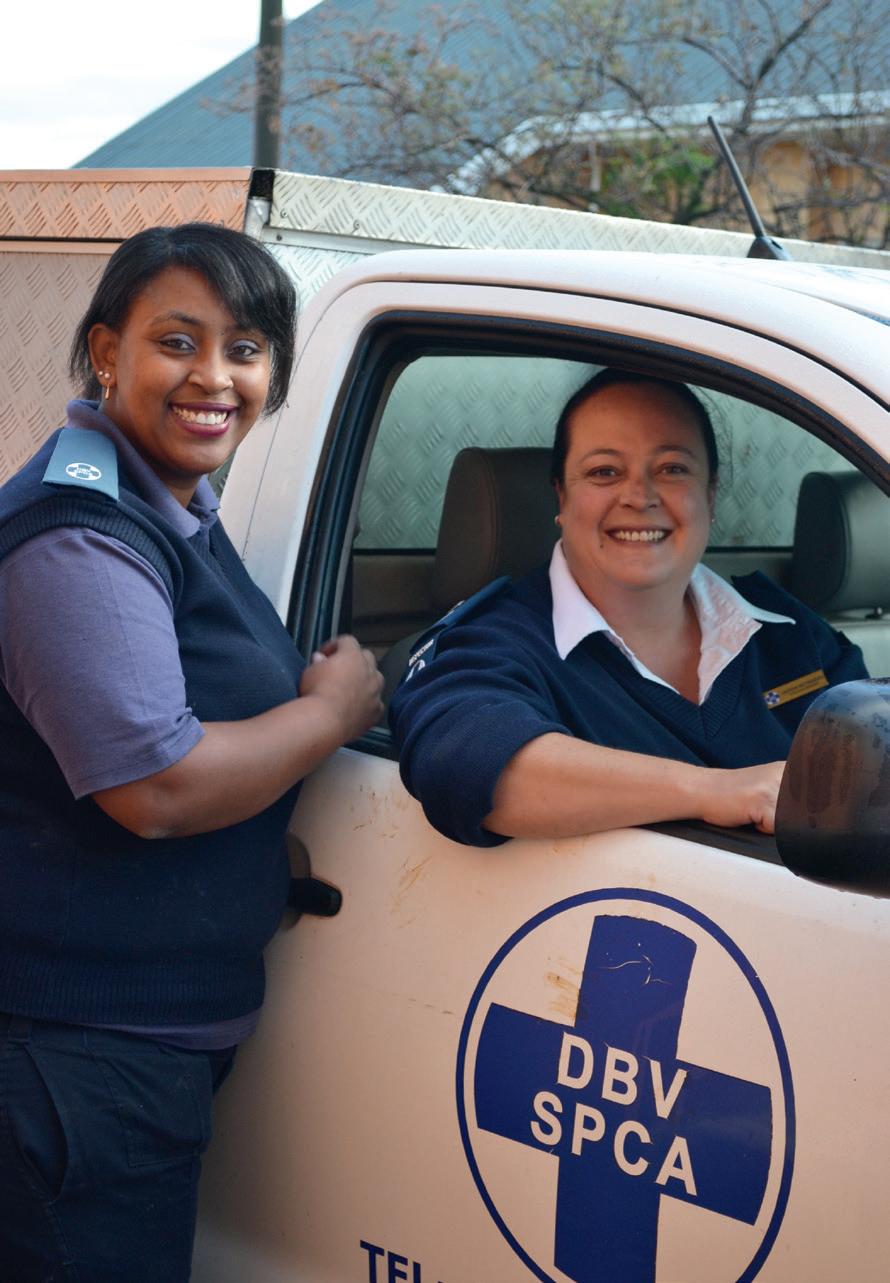
This partnership of government and private entities shows how joining forces can make a positive difference in a small community, thereby emphasising our commitment to being better together.
We are extremely grateful for everyone who assisted or provided us with donations, accommodation, snacks and beverages, our dinners, pet products, and the venue, and all the veterinarians and staff. AP
 by Pavarni Jorgensen, pavarnij@elsenburg.com and Dr Maud Bonato, maudb@elsenburg.com
by Pavarni Jorgensen, pavarnij@elsenburg.com and Dr Maud Bonato, maudb@elsenburg.com
Animal scientists (former and current) from the Directorate: Animal Sciences in the Programme: Research and Technology Development (RTD) received accolades from the South African Society for Animal Science (SASAS) at the gala event of the 51st SASAS congress in Bloemfontein.
Dr Buks Olivier, retired scientific manager of the Directorate: Animal Sciences, was awarded the prestigious SASAS gold medal for his lifetime contribution and service to animal science. The award acknowledges the high quality of Dr Olivier’s scientific contributions, achievements, involvement, and extended service to South Africa’s animal production industry. It honours him
for exceptionally meritorious and acclaimed work, both nationally and internationally.
Mr Pfunzo Tonny Muvhali, a student working at the Oudtshoorn Research Farm, was awarded a SASAS bronze medal in recognition of his master’s dissertation titled “Improving ostrich welfare by developing positive human–animal interactions”. In his work, Tonny clearly illustrated the profound impact of the quality and intensity of interactions between these recently domesticated birds and their caretakers on their physiology, behaviour, health, and productivity. He is now embarking on a project to develop a viable and practical artificial insemination protocol in ostriches for his PhD. He will continue

gaining knowledge of ostrich behaviour and reproductive physiology at the Oudtshoorn Research Farm, in the ultimate quest of becoming one of the few “ostrich whisperers”.
Dr Josef van Wyngaard, former student of the Western Cape Agricultural Trust working at the Outeniqua Research Farm, also received a bronze medal for his PhD study, “Quantification and mitigation of enteric methane emissions from grazing Jersey cows”. Dr van Wyngaard is currently working in the animal nutrition industry.

These achievements of the animal science team highlight the exceptional research contributions to the field of agricultural science by RTD.
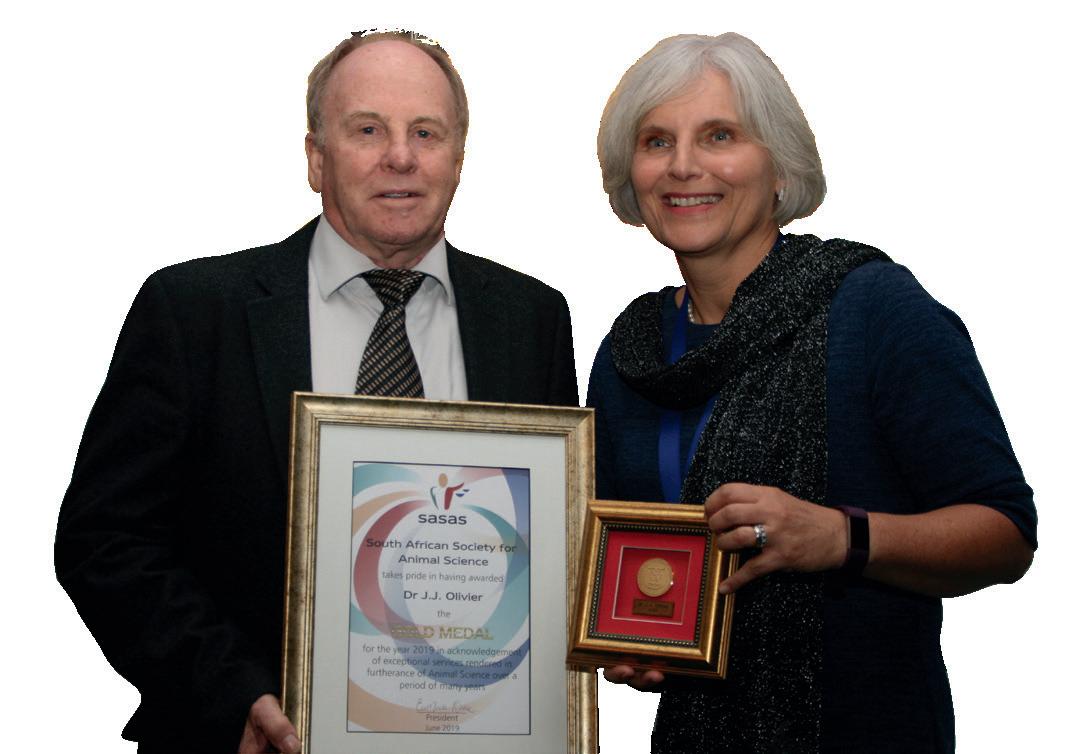
The highly topical theme of the 51st Congress of the Society for Animal Sciences (SASAS) in Bloemfontein, was “Managing the ecological footprint of livestock through efficient production”. Dr Estè van MarleKöster (SASAS president) said in her address, “Improved production outputs need to be achieved by using less land, water, and available energy, while ensuring that the degradation and pollution of natural resources are limited. All food has an ecological impact.” The plenary sessions addressed the major challenges of climate change and the environmental impact of the agricultural sector, and, in a first for the congress, a session on animal welfare was held.
Keynote speaker Dr Christien Engelbrecht (Meteorology, Agricultural Research Council [ARC]) delivered a powerful message on the
effects of low vs high mitigation projections, suggesting that the difference could result in twice the number of heatwave days per year. Dr Frikkie Maré (HOD, Agricultural Economics, University of the Free State) compared the water footprint of cattle breeds, emphasising the differences in blue, green and grey water use as well as the optimal efficiency of production systems. Prof. Michiel Scholtz (ARC, retired) presented research on breeding strategies to lower the carbon footprint of cattle, which included the use of selection for parent-offspring efficiency, crossbreeding and landscape genomics to mitigate effects.
“Can animal welfare contribute to improved production efficiency?” was the title of Dr Kathy Dwyer’s (Scotland’s Rural College) keynote lecture. Her team’s work has demonstrated the significant impact
that good animal welfare can have on production efficiency. Dr Dwyer also discussed species-specific tools that objectively evaluate on-farm animal welfare. These included the Welfare Quality® assessment protocol for poultry, pigs and cattle and the European Animal Welfare Indicators Project (AWIN) welfare assessment protocol for sheep, goats etc.
The welfare session included talks from various perspectives, with Dr Gareth Bath (University of Pretoria) discussing animal welfare from a veterinarian’s point of view while Ms Maricel van Rooyen (University
of the Free State) considered the legal perspective. Dr Maud Bonato (Stellenbosch University) and Prof. Schalk Cloete (retired specialist scientist at the Western Cape Department of Agriculture, currently at Stellenbosch University) talked about their work on ostrich and sheep behaviour, respectively.
A total of 27 papers (both poster and platform presentations) were presented by delegates from the Western Cape Department of Agriculture (WCDoA), including students from the Western Cape Agricultural Research Trust (WCART). AP

All food has an ecological impact.”Waldo van Rensburg (left) and Anieka Muller (right) at SASAS 2019 in Bloemfontein.
In the first article of this series we discussed the basics of 3D printers and how they work. We learnt how it is possible to print a 3D model, but the question is how does it print parts that are suspended in mid-air? And are 3D printed models hollow or solid plastic?







Printing a model that is hollow inside saves on filament and time. Printing only the outside shell can save a substantial amount of time on printing duration but can also weaken the model and cause it to break easily. That is why infill is very important.
Infill refers to the structure printed inside a model, and is designated a percentage and pattern for each job that is printed. The infill percentage and pattern have an influence on printing time, the weight of the model and the structural strength. Usually a 3D model is printed with a 5% to 40% infill, depending on the use of the model.
An infill of 100% is extremely rare and high infill rates of 60% to 80% are used for parts that need extreme mechanical strength.


Infill patterns play a vital role in the strength of the model and the choice of pattern may affect the purpose of the model. Basic models are printed with line infills, while standard models are printed using triangles, grids or tri-hexagons. Functional models that need structural strength would use cubic, octet or the unique gyroid pattern. The gyroid pattern is a wave pattern that has very good structural strength from multiple directions.

Bridging occurs when a 3D model has a flat or near-horizontal part suspended in midair. For obvious reasons a 3D part cannot be printed in mid-air, so a support structure has to be built alongside the model to keep these parts suspended and printed correctly. If the space between the pillars is narrow it is possible to print without using supports, but it would require the settings to be adjusted according to the material specifications. Printing with the speed set too high may cause bad adhesion to the plastic pillar and will cause the plastic to collapse.


A raft is a plastic latticework that is printed underneath the model, so the model is not in direct contact with the build platform. Rafts are mainly used to stop warping, especially with ABS plastic, and for better build platform adhesion. Models with smaller build platform footprints also need rafts to help build a strong foundation. Without the foundation these models would simply detach while printing, ruining the model.
A skirt is a plastic printed line that surrounds the model, but never touches it. Skirts are always printed before the model and helps establish a smooth flow of filament. It is possible that filament only starts to flow a few seconds after a printing job has started, and without a smooth flow of filament proper build platform adhesion may not be possible.
The gyroid pattern is a wave pattern that has very good structural strength from multiple directions.”
A brim is a type of skirt that is attached to the edge of the model. Brims are typically printed with a number of outlines around the model to create rings around the edges. This holds down the edges of a model and prevents warping, and helps with build platform adhesion. A brim may be the preferred option to a raft because it uses less filament and prints much faster.


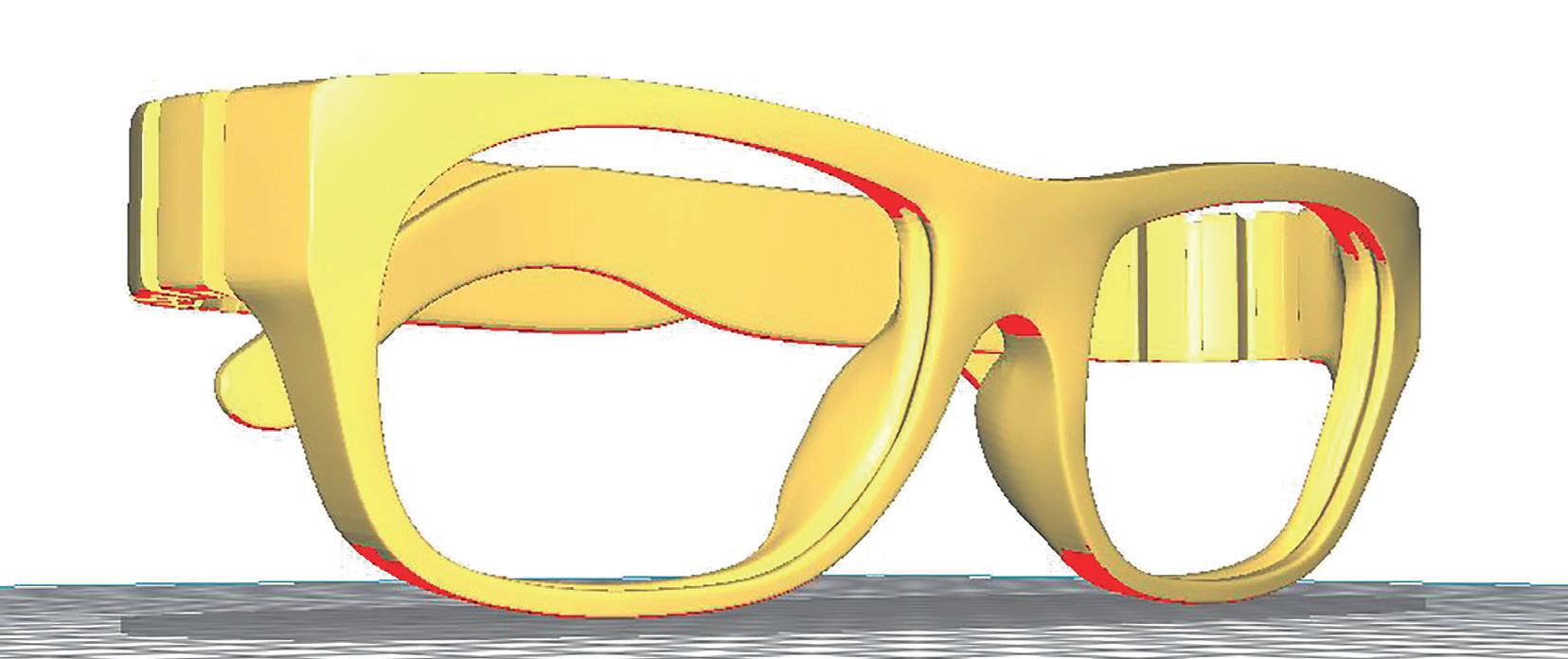
Die Plantpatologie-afdeling van die Direktoraat Plantwetenskappe van die Wes-Kaapse Departement van Landbou doen jaarlikse monitering van ’n canolasiekte genaamd Sclerotinia Stamvrot om die vinger op die pols te hou vir die Wes-Kaapse canolabedryf.

Deel van hierdie moniteringsaksie sluit in om klimaatsdata-“loggers” by verskeie lokaliteite te plaas. Hierdie “loggers” word aan ysterpaaltjies vasgemaak en staan vir die hele seisoen tussen die plante.
Om wind en weer te weerstaan, moet die paaltjies deeglik (en dus diep) ingeslaan word aan die begin van die seisoen. Hierdie paaltjies moet dan weer aan die einde van die seisoen verwyder word voordat die stropers deur die aanplantings kan ry. Dit is in
deur Lizette Nowers, lizetten@elsenburg.com en Johan Roux, johanr@elsenburg.comhierdie stadium waar ’n eenvoudige, maar wesenlike probleem soms kop uitsteek: daardie paaltjies kan vassit!
Meestal is die tegnikus bevoorreg om die hulp van medewerkers te hê om die ysterpaaltjies met brute krag uit die grond te trek, maar daar is tye wanneer almal besig is met hul eie take, veral só kort voor oestyd. In Oktober 2018 het dit gebeur dat die betrokke tegnikus en die helpers tot haar beskikking net nie sommige van die hardnekkige paaltjies uit die grond kon kry nie en daar is wyd en syd gesoek na ’n helper met ’n bietjie groter spiere.
Hierdie insident het haar laat soek na moontlike oplossings om so ’n oënskynlik nietige deeltjie van die projek wérklik ’n nietigheid te maak. Sy het toe besluit dat, voordat sy ’n kontrak by die gimnasium uitneem om meer spiere te bou, sy vir raad gaan aanklop by ’n landbouingenieurskollega.
Die probleem van die klouende paaltjies kon natuurlik op verskeie maniere opgelos word, soos om van die paaltjies ontslae te raak en die “loggers” op ’n ander manier te monteer. Ingenieurs hou egter daarvan om probleme met masjiene of implemente op te los en daarom is ’n implement ontwikkel waarmee die bestaande paaltjies, sonder modifikasie, maklik uit die grond getrek kan word. So ’n implement moes aan die volgende kriteria voldoen:

1. Draagbaar, d.w.s. lig
2. Maklik hanteerbaar en vervoerbaar, d.w.s. kompak en/of opvoubaar
3. Eenvoudig en goedkoop om te maak
4. Eenvoudig om te gebruik
5. Moet op enige paaltjie kan werk
Die paaltjietrekker wat uiteindelik gebou is (sien foto), werk met ’n eenvoudige hefboombeginsel om die gebruiker se krag te verhoog (geen gimnasium nodig nie).
Die voorpunt het ’n gat wat losweg om die paaltjie pas, en skuinsdraai en vasbyt wanneer die trek begin. Die paaltjietrekker is dus maklik en vinnig om te gebruik.
Hoewel die paaltjietrekker reeds die eerste toets geslaag het, word daar uitgesien na die volgende seisoen om dit behoorlik te toets.
Hierdie paaltjietrekker is die produk van die wil om saam te werk en is getrou aan die leuse van die Wes-Kaapse regering, “Beter tesame”. Twee departementele programme het hulle kragte saamgesnoer om ’n probleem op te los.

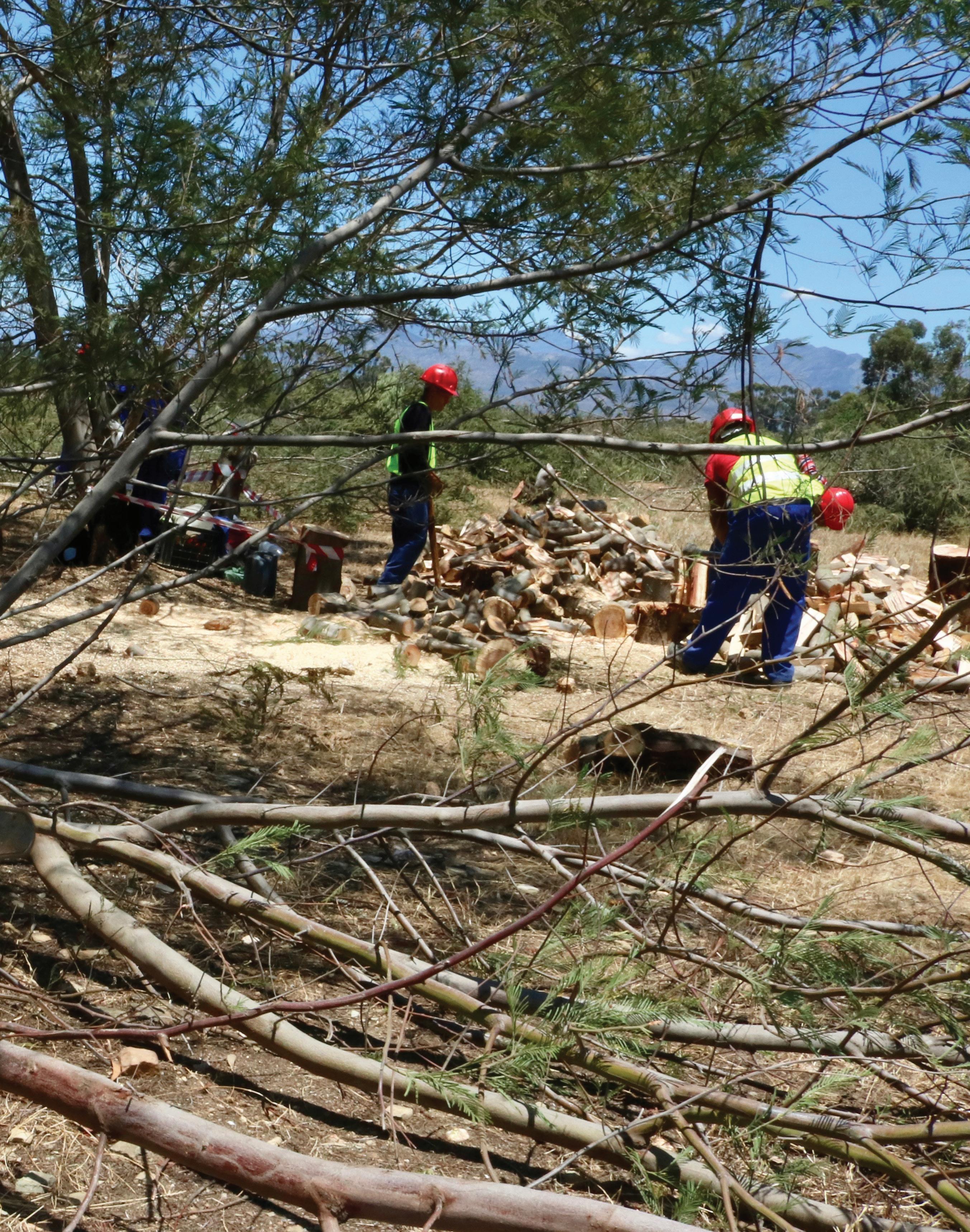 by Heather D’Alton, heather@lovegreen.co.za (commissioned by the sub-programme LandCare, Western Cape Department of Agriculture (WCDoA))
by Heather D’Alton, heather@lovegreen.co.za (commissioned by the sub-programme LandCare, Western Cape Department of Agriculture (WCDoA))
It is not cheap to clear a farm of invasive alien plants. Most landowners can confirm this. A landowner living along the banks of the Breede River would need a budget of around R14 600 just to clear one hectare of densely infested invasive trees, says Chris Meintjies of the WCDoA, LandCare in the Cape Winelands district. That doesn’t include the follow-up costs to keep that hectare clear.
For the WCDoA, LandCare, the lesson has been two-fold: for one, no single partner (be it government or landowners) can carry the costs on their own. Partnerships are essential to cost-effectively remove invasive plants. Also, opportunities exist to create secondary industries from the cleared invasive plants along the Breede River – once again through partnerships.
The focus has specifically been on using
the biomass of felled invasive plants for firewood, mulch and more recently, biochar. Says Meintjies, “Our role is to facilitate the connection between contractors, like wood contractors, and the farmer.”
The programme is funded by the department and co-funded by landowners and other government departments. Around 10 alien clearing teams are active in the municipal area. Once the trees have been cut, four wood contracting teams collect the wood, making firewood or chipping the biomass.
“This is about small businesses, and about how these small businesses develop and work thanks to alien clearing,” says Cape Winelands LandCare Manager, Rudolph Röscher. “We want our ecosystems cleared of invasives. And we’re stimulating a market and creating jobs. These teams are making a business out of it.”

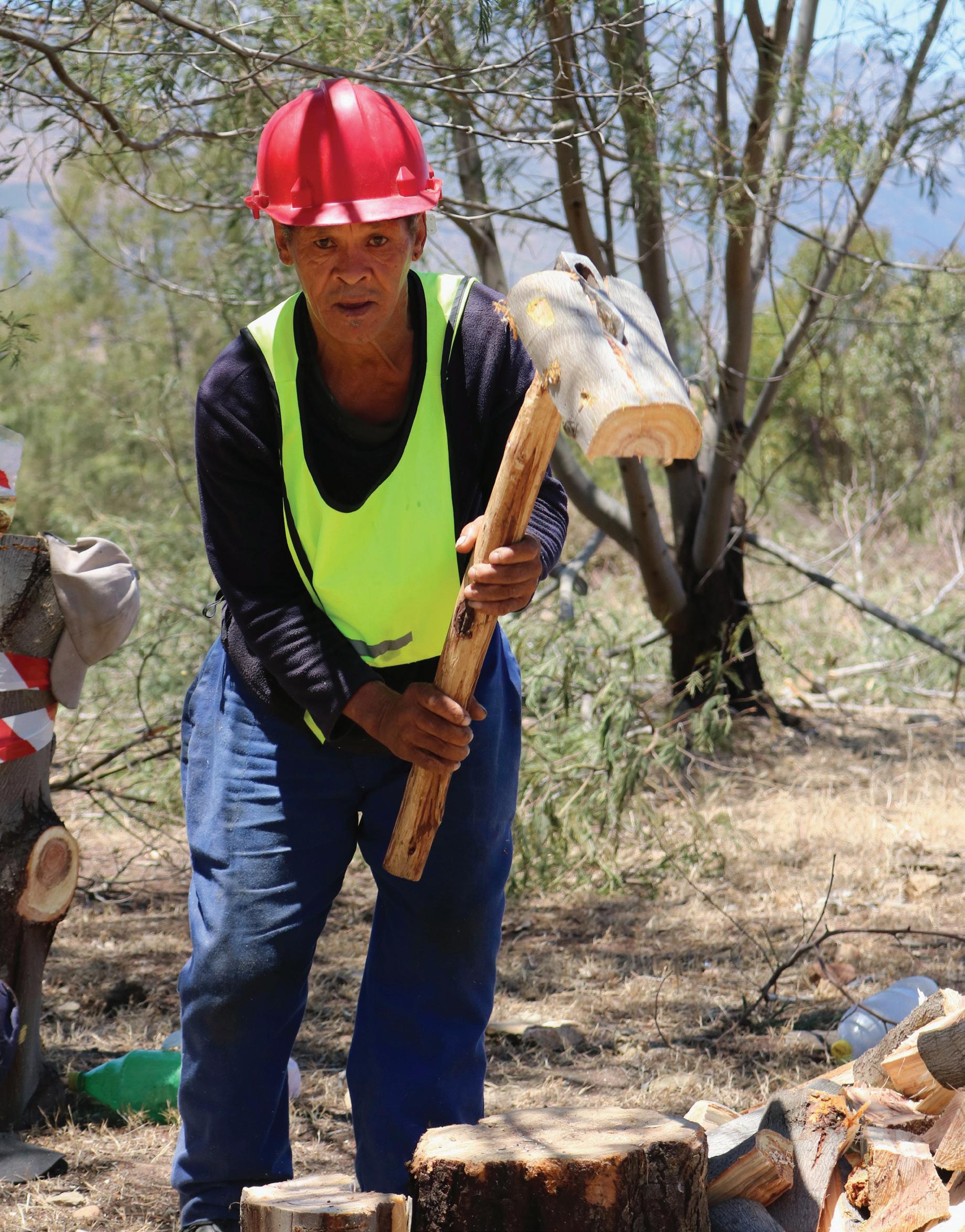

Leading the team at L&J Wood are partners
Jonathan Martin and Lee-Jane Cupido. The team of 12 clears alien plants, makes firewood and chips biomass. The business has been operational since 2015.
“We started by borrowing two axes and buying a saw. But we realised the potential of the business,” says Jonathan. In just two years, the business has expanded to the point that L&J Wood now owns a bakkie, a tractor (named Bertha), a wood splitter and a trailer. Jonathan and Lee-Jane also hire a chipper.
Both Jonathan and Lee-Jane were employed before deciding to start their own business. He worked as a security guard for 13 years. Lee-Jane worked for the South African Police, but after being injured in the line of duty (she was stabbed six times), she opted to not sit behind a desk.
She says, “Like anyone who works for themselves, it will be clear to see if you don’t work hard. So we put in long hours. We have wood available 365 days of the year, and that’s how we have won clients.”
The work is physical in nature, and their team consists of around 20 employees. “We have to keep our team motivated. Many don’t have a high education level. We are a family, and we know we will all struggle if we don’t work hard. So we look after one another,” she says.
Both Lee-Jane and Jonathan are now attending an Expanded Public Works Programme-funded business management course, initiated by LandCare, which has helped them develop their own business plan for the future. Jonathan notes, “Our dream is to use all the wood that is cut – the excess chips and the leaves can be used for compost, and the bark of the trees can be used by nurseries. There is also a market for droppers. We want to try to penetrate all markets.”
Chips have been particularly successful –especially with landowners. “With the water crisis, this is just the solution,” he says. Chips are used for mulch, which is popular on fruit and wine farms. The chips help prevent evaporation of water from the soil – with
“We will all struggle if we don’t work hard”
mulch providing 20% of water savings for farmers. The mulch also stimulates better root growth, and creates the right climate in the soil for micro-organisms to survive.
Now LandCare is also investigating opportunities in biochar. With support from a local non-profit, Breedekloof Wine & Tourism, three biochar kilns have been bought. One of these kilns is now being used by alien-clearing contractor, Linda Jansen, and her team.
Biochar is charcoal that can help to make soil more fertile (especially acidic soils). It is also rich in carbon and is therefore seen as an approach to carbon sequestration. Linda says, “We are now testing the advantages of biochar in our area. We give a few bags to farmers here, to test it on their land. The
market is not yet that well-known, so we’re still trying to highlight the advantages of it. Now farmers want to see what’s in it.”
With the estimated invasion level of the Breede River system at more than 45 000 hectares (if the invasive plants were to be condensed – according to the South African National Biodiversity Institute), there is still much biomass available for small businesses like L&J Wood and for Linda and her team.

According to Rudolph Röscher, “We create a value chain from the invasive alien biomass – first the clearing teams move in, and their work essentially ‘eats up’ the aliens in the river. Then the wood cutters harvest the firewood and then the chipping machines chip whatever is left – thus removing everything from the river and converting it into products that can become part of the agricultural supply chain on the farm while ensuring environmental gains.”

Like anyone who works for themselves, it will be clear to see if you don’t work hard.

1 Directorate: Animal Sciences, Western Cape Department of Agriculture, PO Box 351, Oudtshoorn, 6220, South Africa
2 Directorate: Animal Sciences, Western Cape Department of Agriculture, Private Bag X1, Elsenburg, 7607, South Africa
3 Department of Animal Sciences, University of Stellenbosch, Private Bag X1, Matieland, 7602, South Africa
4 Department of Agriculture and Animal Health, University of South Africa, PO Box 392, UNISA, 0003, South Africa
The ostrich industry, both local and abroad, has been burdened with perpetual uncertainty due to outbreaks of disease and fluctuating markets. A major constraint to effective production is high levels of hatching failure. An improved understanding of the hatching sequence around the pipping period may allow for a better understanding of embryonic mortality, resulting in benefits to the entire ostrich industry.
The low production of ostriches is still a global concern, specifically low chick production. Studies focussed on factors influencing fertility, hatchability and incubation in ostriches have been done. However, there is still a poor understanding of the pattern of embryonic development during incubation. Although there are some basic guidelines, the success rate for hatching of ostrich eggs is typically between 30% and 60%. A clear understanding of the pipping process,
as well as factors contributing to eggs not hatching, is crucial (Brand et al., 2017). This paper presents a preliminary description of the stages of the hatching sequence against this background.
In previous studies, eggs were identified according to the descriptions and illustrations published by Deeming (1995b). Accordingly, six stages were identified in the hatching sequence of the ostrich (Struthio camelus):
• Stage A – pre-internal pipping
• Stage B – internal pipping
• Stage C – external pipping;
• Stage D – consolidation of pipping hole
• Stage E – emergence
• Stage F – drying off
Bruning (1973; 1975) stated that there was a tendency by hatcher managers to assist ostrich embryos during hatching by breaking the eggshell after the chick pipped.
During candling on day 38 of incubation, a definitive uninterrupted division line between the body of the chick and the air space was found (Fig. 1). At this stage, a small area in the division line became interrupted by an isosceles triangular shadow (two equal sides). This is the beak of the chick, changing in intensity due to the forward and backward movements of the head of the chick.


At the commencement of this stage, the division line became interrupted at more than one point (Fig. 2). The isosceles triangle was still visible, but a scalene triangle (unequal sides) was also visible, showing the right toe of the chick. Additionally, the neck was seen as an irregular semicircular shadow protruding from the division line. As this stage progressed, the uninterrupted division line between the chick and air space became completely irregular. Furthermore, a light reflection appeared on the long side of the egg indicating the embryo’s stomach. As the inner membrane tore away from the shell, the light-reflecting area on the long side of the egg increased
in size, indicating that the embryo was in the correct pipping position.
The first breakage of the shell indicated that the chick moved to Stage C (Fig. 3). During this stage, the chick created a pipping hole to weaken the protective shell. Combining its feet and beak, the embryo kicked and pecked until the pipping hole was established. The hole started out as a star-like crack in the shell, which gradually enlarged as the chick continuously kicked and moved its body inside the shell. As the size of the pipping hole increased, the beak and right toe of the correctly positioned chick became visible. At this point the head of the embryo was turned from right to left, with the right eye facing the hole.
Stage D started as the beak and toe moved away from the initial pipping hole (Fig. 4). At first it was difficult to see the beginning of this stage, because the chick’s beak and toe remained positioned for the correct pipping position as established in Stage C. However, with time the tip of the beak and toenail
started to move away from the point where the initial weak point in the shell was made. During this stage the chick performed an approximate 90-degree counter-clockwise turn in a diagonal direction towards the equator of the egg (Deeming, 1995b). This turning action caused the line of fracture in the shell to extend from the air space end of the egg to the equator of the egg. As the chick turned inside the egg, the right
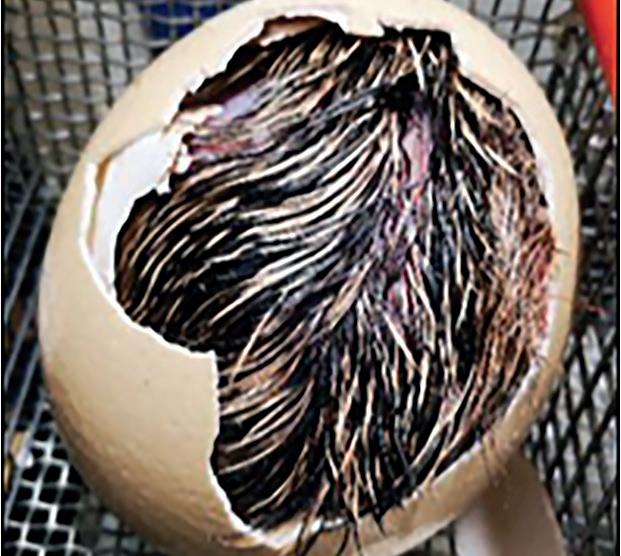

knee and wing became visible, while both the beak and toe completely disappeared from view. While the chick continued to turn, the spine also came into view.

During the turning process the head of the chick did not change position (relevant to the body), leaving the chick to free its head from both under its body and inside the egg. The position of the head put the chick in a potentially vulnerable position at this stage, as it turned away from fresh air. This could potentially lead to suffocation if the chick could not free its head swiftly enough. The base of the neck started to show through the pipping hole and with simultaneous kicking and bodily movements, progressively more of the neck’s surface protruded from the hole, leaving the head just inside the hole. The last observation made during Stage D was the left wing coming into view through the pipping hole, indicating the completion of the 90-degree turn.
The ostrich chick continued kicking and moving to allow for a big enough piece of the shell to break away, allowing for the head to
During Stage F (defined as climax), the chick broke free completely from the eggshell (Fig. 6). The chick was still attached to the inner membrane via the umbilical cord in very early phases, but detached as soon as the membrane dried. The feathers of the chick felt dry to the touch, but the legs and neck still showed signs of visible and palpable oedema. Chicks were unbalanced and not yet vocal, although some chirps were heard.

As Stage F progressed, the feathers became completely dry and, although the neck of the chick was still slightly oedematous, the legs showed no signs of oedema. The chick became more balanced and very vocal.
emerge from the egg (Fig. 5). Stage E started when the head was free. At this point the shell was either partly or completely broken, but the chick remained partially inside the shell. At this time, the chick was moderately wet, with both visual and palpable oedema in the legs and neck. Stage E is short with very few variables.
Since artificial incubation has become an essential part of commercial ostrich farming in South Africa, it is essential to understand the hatching process of a viable chick. This knowledge will help in setting up guidelines for hatcheries to refine and optimise the hatching process. The ostrich industry will benefit as a whole. AP
Brand, Z., Cloete, S.W.P., Malecki, I.A. & Brown, C.R. 2017. Dead-in-shell positions of near-term ostrich embryos. South African Journal of Animal Science, 47(1):1-6.
Bruning, D.F. 1975. Social structure and reproductive behaviour in the Greater Rhea. Living Bird, Cornell Lab of Ornithology (CLO), 13(1):254-294.
Bruning, D. 1973. Breeding and rearing rheas in captivity. International Zoo Yearbook, 13:458-466.
Deeming, D.C. 1995(a). Factors affecting hatchability during commercial incubation of ostrich (Struthio camelus) eggs. British Poultry Science, 36:51-65.
Deeming, D.C. 1995(b). The hatching sequence of ostrich (Struthio camelus) embryos with notes on development as observed by candling. British Poultry Science, 36:67-78.









Is a quarterly magazine, distributed to subscribers at no charge by the Western Cape Department of Agriculture.
Subscription
For free subscription to this quarterly magazine, please submit your details to Magrieta de Lange.
Tel: 021 808 7613
Email: info@elsenburg.com
Contact us
Western Cape Department of Agriculture
Tel: 021 808 5111
Email: info@elsenburg.com
Web: www.elsenburg.com
Printing Shumani RSA
Tel: 021 951 6391
Packaging
Stellenbosch Work Centre for Adults with Disabilities
Tel: 021 887 8688
Email: jjja@sun.ac.za
You can also read your copy online and subscribe at www.elsenburg.com/resource-library/agriprobe
Don’t forget to tune into RSG Landbou every Friday morning at 04:45 and on Saturdays at 11:45. Listen to the highly informative programmes on the Western Cape Department of Agriculture and the Agricultural Sector in general. If you miss it on the radio, you can also listen to the programmes of the week on www.elsenburg.com/resource-library/radio-elsenburg
Luister elke Vrydagmiddag om 12:45 na Die Kwik Styg op RSG waar kenners gesels oor klimaatsverandering.